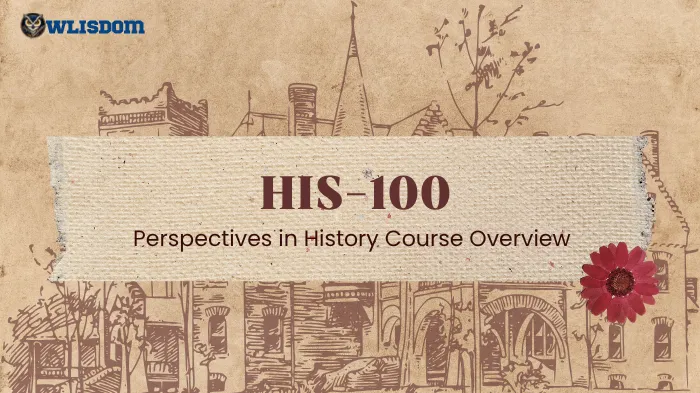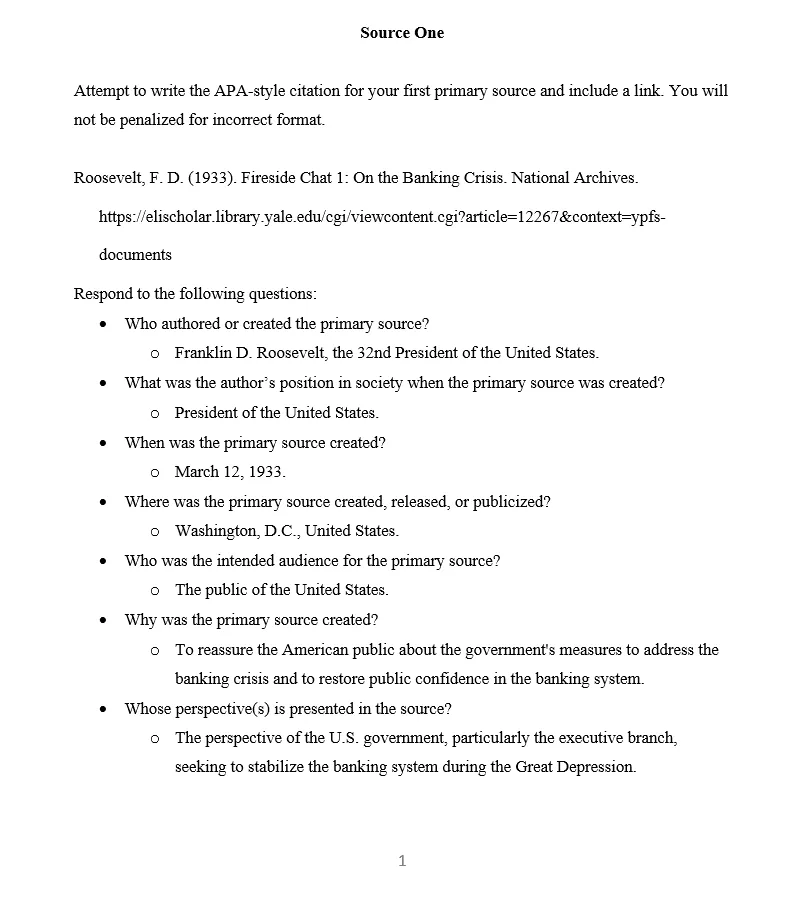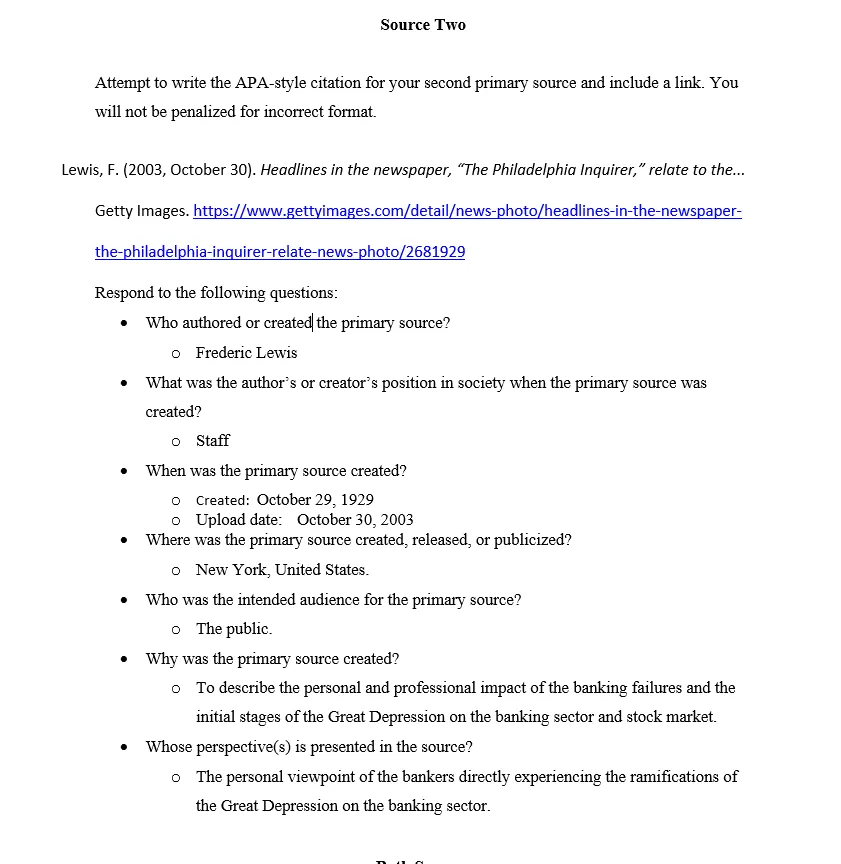HIS-100: Perspectives in History — Course Companion & Writing Guide
Published: 2025-10-06
Modified: 2025-10-06
Samples Solutions
Introduction:
Welcome to HIS-100 — Perspectives in History, where you’ll explore how historians interpret the past through political, social, and cultural lenses. This guide covers key themes, assignments, and analysis strategies. For expert writing support, visit Owlisdom’s History Homework Help.
HIS 100 1-1 Discussion: Why Should We Study History?
Instructions for HIS 100 1-1 Discussion: Why Should We Study History
Discussion: Why Should We Study History?
Welcome to your first discussion in HIS 100. This space is meant to be collaborative for conversations about the course concepts and for learning from your peers’ diverse perspectives. To ensure an interesting discussion, you are encouraged to think creatively about your initial posts and extend the points made by your peers. It is also important to review the module resources and read the prompts in their entirety before participating in the discussion.
Create one initial post and follow up with at least two response posts.
For your initial post, address the following:
- Introduce yourself to the class.
- What degree are you pursuing, and why?
- Where do you live?
- What else would you like us to know about you?
- Discuss the value of studying history for everyone, not just historians. Why might it be important for individuals and society to know the history behind current events?
- Consider a recent event you have read about or seen in the news. In a few sentences, describe how knowledge of a past historical event could help you better understand the current event.
For your response posts, address the following:
- Describe your understanding of your peer’s current event by providing additional historical elements that may have contributed to the current event. Discuss the similarities and differences between your and your peers’ perspectives.
Remember, this assignment is graded on the quality of your initial post and at least two response posts to your classmates. If you refer to any module resources, be sure to include an attribution (or citation) for the resource.
To complete this assignment, review the Discussion Rubric.
Introduction To HIS 100 1-1 Discussion
Welcome to the How-To Guide for HIS 100 – Perspectives in History. This guide is crafted to make your journey through HIS 100 engaging, insightful, and, most importantly, manageable. Your active participation is key to the success of this learning experience.
We will confidently tackle the HIS 100 Discussion posts, Assignments, and Module Milestones.
As you embark on this extensive journey, remember that your active participation is key. Each step of this How-To Guide comes with a sample solution to help you understand exactly what to do. You can look forward to our tips and tricks—consider them our little gift to you. So, let us solve the HIS 100 1-1 Discussion: Why Should We Study History? with ease and expertise.
Introduce yourself to the class. What degree are you pursuing, and why? Where do you live ? What else would you like us to know about you?
Introduce Yourself
To start, begin with your short introduction.
Share Your Background: Start by saying hello to your classmates. Mention your name and a fun fact or hobby to make things interesting.
Discuss Your Academic Pursuits: Talk about your major or the degree you are aiming for and explain why you chose it. Keep it light and straightforward.
Offer Personal Insights: Is there something unique about where you live or your historical perspective? Your unique viewpoint is valuable, so please share it here!
Example
Hey there, classmates! I am Alex, and aside from being a history buff, I am an avid hiker. I am pursuing a degree in History because I am fascinated by how past events shape our present and future. Understanding history gives us insights into solving current problems. Living near historical landmarks has always inspired me, offering a tangible connection to the stories I study. It is incredible how much the past is woven into the fabric of our daily lives.
I am looking forward to learning and sharing with all of you!
Discuss the value of studying history for everyone, not just historians. Why might it be necessary for individuals and society to know the history behind current events?
The Importance of Studying History
It is time to explore the HIS 100 1-1 Discussion: Why Should We Study History? This section discusses the importance of studying history.
- Understand History’s Value: Explain in your own words why learning about history is not just for historians. History helps us understand different cultures, learn from past mistakes, and shape our future.
- Impact on Society: Try to connect how knowing about historical events can help us make sense of current news or societal trends. Use simple examples if you can.
Example
Studying history is not just for historians; it is crucial for everyone. It lets us understand diverse cultures and learn from past errors to make better choices today. For instance, we can apply those lessons to current situations by examining how societies dealt with past challenges, like pandemics or economic crises. Understanding the history behind news stories not only helps us grasp the root causes of modern conflicts or trends but also equips us with the knowledge to be more informed citizens. History guides us, offering insights and cautionary tales that help us navigate the present and plan.
Consider a recent event you have read about or seen in the news. In a few sentences, describe how knowledge of a historical event could help you better understand the current event. Connecting Past and Present in HIS 100 1-1 Discussion: Why Should We Study History?
Let us proceed to the section where we will discuss the link of history to our current world.
Link Historical Events to Current News: Pick a recent news story you found interesting. Briefly describe it, then think of a historical event that reminds you of this story. Explain how this past event helps you understand the current one better.
Example
Recently, much talk has been about climate change causing extreme weather patterns. This reminds me of the Dust Bowl of the 1930s in the United States (Cowan et al., 2020), where poor land management and drought led to widespread crop failures and dust storms. By comparing these two events, we see how human actions and natural forces can combine to create environmental crises. Understanding the Dust Bowl teaches us the importance of sustainable practices and being prepared for climatic changes, offering valuable lessons on addressing today’s ecological challenges better and preventing similar disasters.
Describe your understanding of your peer’s current event by providing additional historical elements that may have contributed to it. Discuss the similarities and differences between your and your peers’ perspectives.
Peer Responses for HIS 100 1-1 Discussion: Why Should We Study History?
Onward to this section, we will discuss engaging with peers and responding to their questions.
- Discuss a Peer’s Perspective: Read a classmate’s post about a current event. Try to add to their analysis by mentioning another historical event or detail they did not include. Discuss any similarities or differences in your viewpoints.
- Compare and Contrast: Focus on understanding different perspectives and how history can be viewed through multiple lenses. Be respectful and open-minded in your comparisons.
Example Peer Reply of HIS 100 1-1 Discussion: Why Should We Study History?
Hey Alex, great post! I agree with your connection between historical events like the Dust Bowl and current environmental issues. It is fascinating how history can provide a lens through which we view and respond to today’s climate challenges. While you highlighted the impacts of poor land management and natural droughts contributing to the Dust Bowl, it is also crucial to consider the economic pressures of the Great Depression, which exacerbated the crisis by pushing unsustainable agricultural practices (Chaudhuri, 2014). This historical context enriches our understanding of how economic, environmental, and policy factors interplay, just as they do today with climate change, underscoring the need for integrated solutions. Your focus on learning from the past to address contemporary problems resonates with me as we both see history as a tool to better understand and tackle current challenges.
Reference
Chaudhuri, R. R. (2014). The Great Depression and the Glass-Steagall Act. In R. R. Chaudhuri (Ed.), The Changing Face of American Banking: Deregulation, Reregulation, and the Global Financial System (pp. 71–82). Palgrave Macmillan US. https://doi.org/10.1057/9781137361219_6
Closing HIS 100 1-1 Discussion: Why Should We Study History?
Following these guidelines will fulfill the HIS 100 1-1 Discussion: Why Should We Study History? Requirements and help you better understand the intricate relationship between the Perspectives of History. We hope you nail this HIS 100 1-1 Discussion post. Good luck!
References
Cowan, T., Hegerl, G. C., Schurer, A., Tett, S. F. B., Vautard, R., Yiou, P., Jézéquel, A., Otto, F. E. L., Harrington, L. J., & Ng, B. (2020). Ocean and land forcing of the record-breaking Dust Bowl heatwaves across the central United States. Nature Communications, 11(1), 2870. https://doi.org/10.1038/s41467-020-16676-w
Dogaru, L. (2020). The Main Goals of the Fourth Industrial Revolution. Renewable Energy Perspectives. Procedia Manufacturing, pp. 46, 397–401. https://doi.org/10.1016/j.promfg.2020.03.058
HIS 100 2-1 activity: historical research questions
Instructions for HIS 100 2-1 Activity: Historical Research Questions
Assignment
Overview
All historical research begins with asking good questions, and who asks the questions matters. It is also important to ask how history is represented, whether in textbooks and media reports or by governments and independent organizations. Developing historical inquiry skills will help you ask critical questions about headlines you see or claims you hear. In this activity, you will take the first step toward developing those skills by writing a research question about your chosen historical topic.
Keep in mind that you cannot change your topic after this module. Please remember to review and keep all instructor feedback. Each module activity will prepare you for an aspect of your final project, and you will have a future opportunity to improve your work.
Prompt
In this activity, you will make your final topic selection and write a research question that is clear, relevant, and focused. Your research question will evolve as you progress through the course, so what you write now is not final. You will then attempt to look at your historical topic from a different person’s perspective. Use the provided HIS 100 Module Two Activity Research Question Template Word Document to complete this assignment.
Specifically, you must address the following rubric criteria:
- Write a clear, relevant, and focused research question about the topic you have selected.
- Refer to the module overview and resources for helpful information about writing effective research questions.
- Explain how another person’s beliefs, assumptions, and values may lead that person to create a different question than you.
Guidelines for Submission
Use the provided Module Two Activity Template: Historical Research Question to address the steps above. While references are not required, any sources used should be cited according to APA style if you reference them in your responses. Consult the Shapiro Library APA Style Guide for more information on citations.
Introduction to HIS 100 2-1 activity: Historical Research Questions
This How-To Guide will provide a descriptive and detailed overview of the HIS 100 Module Two 2-1 Activity. Module Two of HIS 100 revolves around the Historical Research Questions. I am using the template for the HIS 100 2-1 Activity by Southern New Hampshire University as an example. If you are studying the course Perspective of History from another institute, the template for this activity has the exact instructions. I will provide you with a sample solution of the template along with this guide.
You can check out other modules of HIS 100 as well.
Instructions
Let us briefly discuss the significant instructions for the HIS 100 2-1 activity: historical research questions.
Write a historical research question that addresses an aspect of your finalized topic. Non-graded portion: List your historical research topic here.Graded portion: Write a straightforward, relevant, focused research question about your finalized topic. Explain how another person’s beliefs, assumptions, and values may lead that person to create a different question than you.
Introduction to The Topic
We must have a better and more precise understanding of our research topic.
- Understand the Scope: Ensure you broadly understand your chosen topic. This could include its causes, effects, key figures, and significant events.
- Narrow Your Focus: Choose a specific aspect of the topic that interests you. Examples include economic policies, social impacts, cultural shifts, etc.
- Write Your Topic: Clearly state your focus area within the topic.
Example

Write a straightforward, relevant, focused research question about your selected topic.
Formulating Research Question for HIS 100 2-1 activity: historical research questions
In Module Two HIS 100 4-1 Activity, we will learn how to formulate the research question.
- Begin with a general area of interest and narrow it down to a specific question that can be researched.
- Your question should be straightforward, avoiding ambiguity about your question.
- It’s important that your question directly relates to the Great Depression and your chosen focus area, as this historical event had a profound impact on various aspects of society and is a rich source of research questions.
Example

Explain how another person’s beliefs, assumptions, and values may lead that person to create a different question than you.
Analyzing Different Perspectives
In this section of the HIS 100 2-1 activity: historical research questions, we will delve into the enlightening process of discussing and analyzing different perspectives of our research. Understanding these perspectives will open your mind to new ways of thinking about history.
- Consider how someone from another background or with different values might view your topic.
- It’s important to acknowledge how your background or beliefs might shape your question. This self-awareness will make you a responsible researcher. Compare this to potential others to ensure a balanced perspective.
- Provide examples of how different perspectives could lead to other questions. For instance, someone focusing on economic recovery might ask.
- In a few sentences, articulate how and why different perspectives could shape research questions. Be sure to reflect on the complexity and multifaceted nature of historical interpretation.
Example
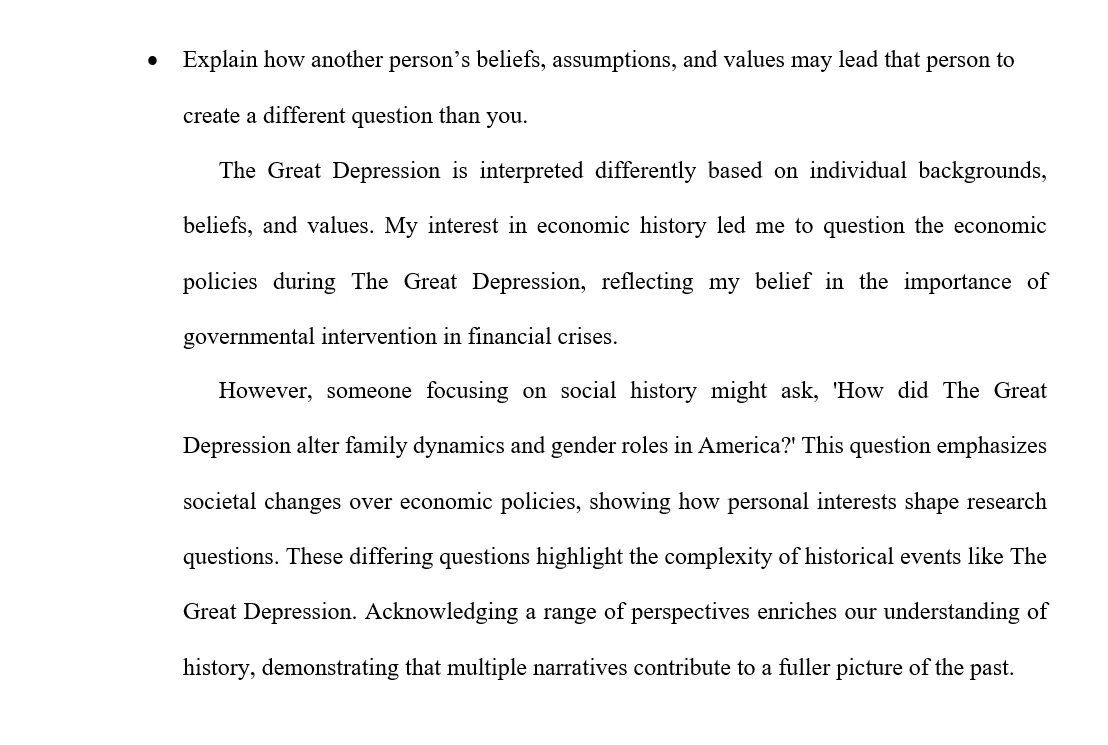
Closing
This How-To Guide provides descriptive and easy guidelines for solving Module Two HIS 100 2-1 activity: historical research questions. Remember that Southern New Hampshire University gives this template to the students of HIS 100. I have solved this template as an example. If you want me to solve a similar activity with a different template, you can request a solution. You are not alone in this journey; we are here to guide you.
HIS 100 2-2 activity: Primary and Secondary Sources
Instructions for HIS 100 2-2 activity
Overview
Using relevant and trustworthy sources is a key element of conducting research in any field. Primary and secondary sources provide information necessary for historians to develop theories or interpretations about the past. In this activity, you will explore the existing literature relevant to your research question and identify one primary and one secondary source that will help you answer your research question.
Please remember to review and keep all instructor feedback. Each module activity will prepare you for an aspect of your final project, and you will have a future opportunity to improve your work.
Prompt
Use the provided Module Two Activity Template: Primary and Secondary Sources Word Document to complete this activity. You will first discuss the differences between primary and secondary sources and articulate why using both is essential to historical research. You will then identify sources relevant to the research question you wrote in the previous module. Finally, you will identify a current event related to the subject of your historical research question.
Specifically, you must address the following rubric criteria:
- Distinguish between primary and secondary sources.
- What are the differences between them?
- Explain why it is important to consult a variety of sources when conducting historical
research.
- Why should you avoid relying only on one type of source? What are the benefits of using a diversity of sources?
- Identify one primary source that would help investigate your research question.
- Using the HIS 100 Library Guide in the Shapiro Library, skim through the suggested resources or find your own from the Shapiro Library. Ensure they are credible and relevant to your research question.
- Identify one secondary source that would help investigate your research question.
- Using the HIS 100 Library Guide in the Shapiro Library, skim through the suggested resources or find your own from the Shapiro Library. Ensure they are credible and relevant to your research question.
- Choose a current event related to the subject of your research question and explain how they
are connected.
- Read what you wrote in the previous module’s activity about how your historical topic is relevant to modern society. Using your response and what you have learned thus far about your topic, identify a specific current event that you feel is relevant to your research question. Then explain how the current event is connected to your research question. Keep in mind that the link between your topic and your current event will become clearer as you continue to research.
Guidelines for Submission
Submit the Module Two Activity Template: Primary and Secondary Sources. While references are not required, any sources used should be cited according to APA style if you reference them in your responses. Consult the Shapiro Library APA Style Guide for more information on citations.
Step-by-Step Guide to HIS 100 2-2 Activity: Introduction to Primary and Secondary Sources
This How-To Guide will provide a descriptive and detailed overview of the HIS 100 2-2 activity: Primary and Secondary Sources. In HIS 100, Module Two is based on Historical Research Questions, but this activity is related to the type of sources we would apply in the same module. For this purpose, I have chosen the template of the HIS 100 2-2 Activity from Southern New Hampshire University. If you are taking a course called The Perspective of History from another institute, the outline for this activity has the same steps. In addition to this guide, I will share a dummy solution of the template with you.
Distinguish between primary and secondary sources. Explain why it is essential to consult various sources when conducting historical research. Include specific details and examples. Identify one primary source to help investigate your research question (include the title, author, and link to the source). Identify one secondary source that would help investigate your research question (include the title, author, and link to the source). Choose a current event related to the subject of your historical research question and explain how they are connected.
Instructions
Let’s focus on and recall the primary and secondary sources of HIS 100 2-2 activity steps.
Distinguishing Between Primary and Secondary Sources
Let us clarify the difference between primary and secondary sources for HIS 100 2-2 activity: Primary and Secondary Sources.
- Explain the meaning of the primary sources with examples of the Great Depression.
- Explain secondary sources and provide examples of the great depression.
Example

Importance of Using a Variety of Sources
In HIS 100 2-2 activity Primary and Secondary Sources, we will discuss the different sources’ roles in historical studies.
- Explanation of different kinds of biases in the sources.
- Advantages of using primary as well as secondary source materials.
Example
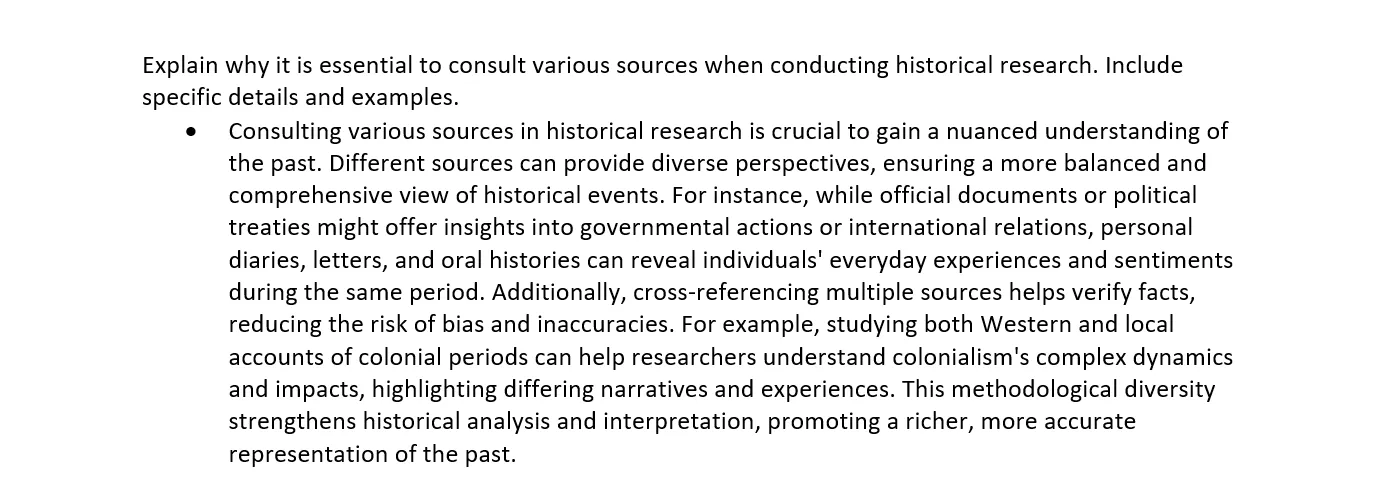
Identifying Sources for Your Research Question
Now, let us dive into the sources for HIS 100 2-2 activity: Primary source and Secondary source.
- Locate one primary source that is relevant to the topic you’ve chosen.
- Select a secondary source relevant to your topic.

Connecting Historical Research to a Current Event
Let us unwrap the section of HIS 100 2-2 activity: Primary and Secondary Sources, where we will talk about how history relates to a current event.
- Suggestions for choosing a current event.
- What is the relationship of this event to the Great Depression and the modern economy?
Example
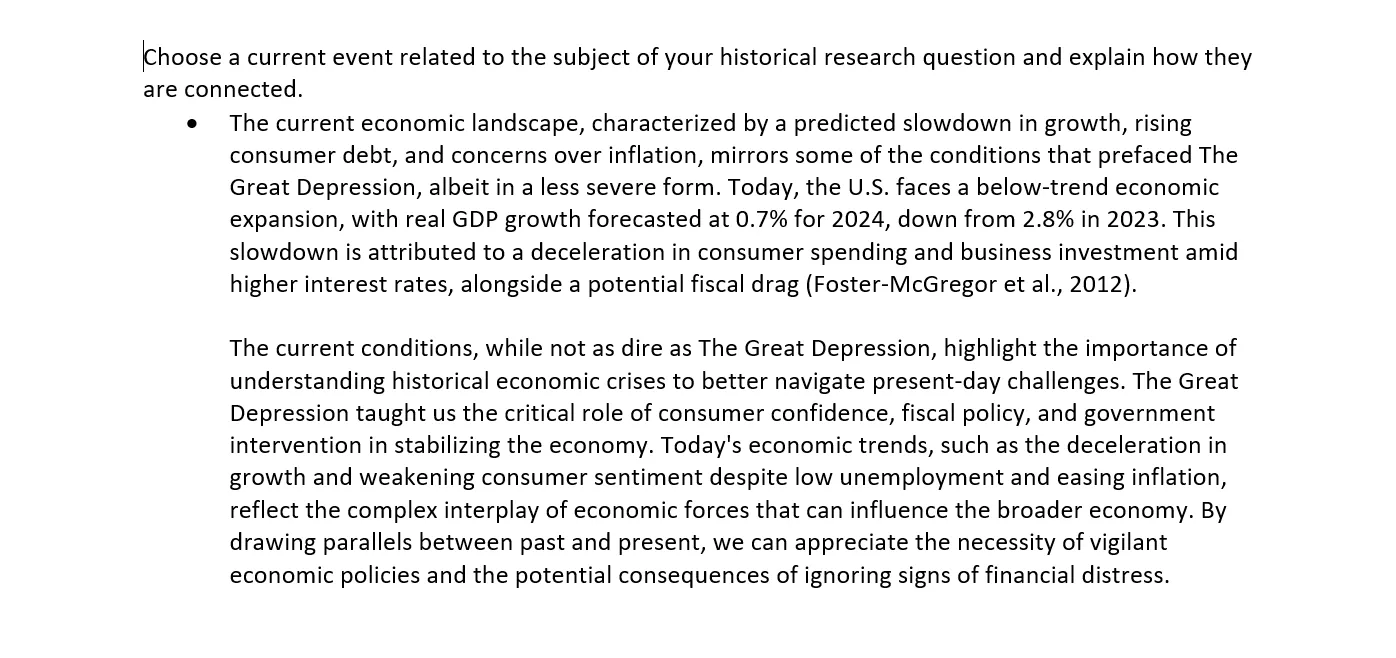
Closing
This Owlisdom How-To Guide provides descriptive and easy guidelines for solving HIS 100 2-2 activity: Primary and Secondary Sources Questions. Remember that Southern New Hampshire University provides this template to the learners of HIS 100. I have solved this template as an example. If you want me to solve a similar activity, you can ask for a solution with a different template. You can also read our HIS 100 next module 3-1 Activity: Examining Historical Context.
HIS 100 3-1 Activity: Examining Historical Context
Instructions of HIS 100 3-1 Activity
Overview
No historical event occurs in a vacuum. Instead, each event is connected to another and larger political, social, cultural, and economic issues. In previous modules, you identified a topic, a historical event, and a current event related to one another. In this activity, you will dig deeper into the broader context and perspectives surrounding your selected historical event.
Prompt
Use the provided Module Three Activity Template: Historical Context Word Document to complete this activity. First, you will describe the context of your historical event using evidence from the sources you have explored. You should focus on a particular historical perspective (social, political, or economic) to describe what was occurring at the time. For example, if you were researching the establishment of Martin Luther King, Jr. Day, you could focus on the political context of the Civil Rights Movement and the Voting Rights Act of 1965. Next, you will examine how and why a key figure or group participated in the historical event. Use the “historian think aloud” examples from the module resources as inspiration for how you might answer these questions.
Specifically, you must address the following rubric criteria:
- Describe the historical context surrounding your historical event.
- Use one of the perspectives mentioned in this module’s overview (social, political, economic) to focus your description and highlight particular influences on the event.
- Describe a key historical figure or group’s participation in your historical event.
- In your description, identify that figure or group’s position/role in society and their role in the event.
- Explain the key historical figure or group’s motivation to participate in your historical
event.
- In your explanation, include how you think the figure’s or group’s beliefs, assumptions, and values influenced how they perceived the event and the person’s ability to directly or indirectly affect it.
- Articulate how the historical context caused or influenced your chosen historical event.
- How do you think what was going on in broader society at the time impacted your historical event?
- Explain how connecting your historical event and current event improves the understanding of
your topic.
- How do you think using your historical event to explore the roots of your current event might help you better understand your topic (climate change, political protest, human rights/inequality, or global trade)?
Guidelines for Submission
Submit the Module Three Activity Template: Historical Context. While references are not required, any sources used should be cited according to APA style if you reference them in your responses. Consult the Shapiro Library APA Style Guide for more information on citations.
Exploring Historical Context: A Step-by-Step Guide And Introduction to HIS 100 3-1 Activity
This Owlisdom How-To Guide will provide a brief yet detailed overview of the HIS 100 3-1 Activity: Examining Historical Context. The third module of HIS 100 is focused on Examining Historical Context. For this demonstration, I am using the templates of the HIS 100 by SNHU. If you are taking Perspective of History from another institute, then this template contains the exact instructions for this activity. You can get a dummy solution of the template accompanying this guide from me. For the course research, I have selected The Great Depression and the US economy as the historical event.
Describe the historical context surrounding your historical event. Use one of the perspectives mentioned in this module’s overview (social, political, economic) to focus your description and highlight influences on the event.

Historical Context of The Selected Event
In this section of HIS 100 3-1 Activity: Examining Historical Context, let us dwell on the historical background of the historical event you chose. Thus, I have decided to write about the Great Depression. Consequently, I will be solving the provided template on this topic as follows:
- Provide background information about your topic with special emphasis on its beginning, consequences, and duration.
- While having mass influence and consequences, the events of the past must be viewed in the context in which they occurred.
- Choose whether to concentrate on social, political, or economic factors. From a financial perspective, if you choose, research the stock market crash, the failure of banks, and the unemployment rate.
- Employ the use of scholarly books and journals as well as credible sites and other historical sources. One should read them through newspapers of the time, personal correspondence, and government documents.
Example
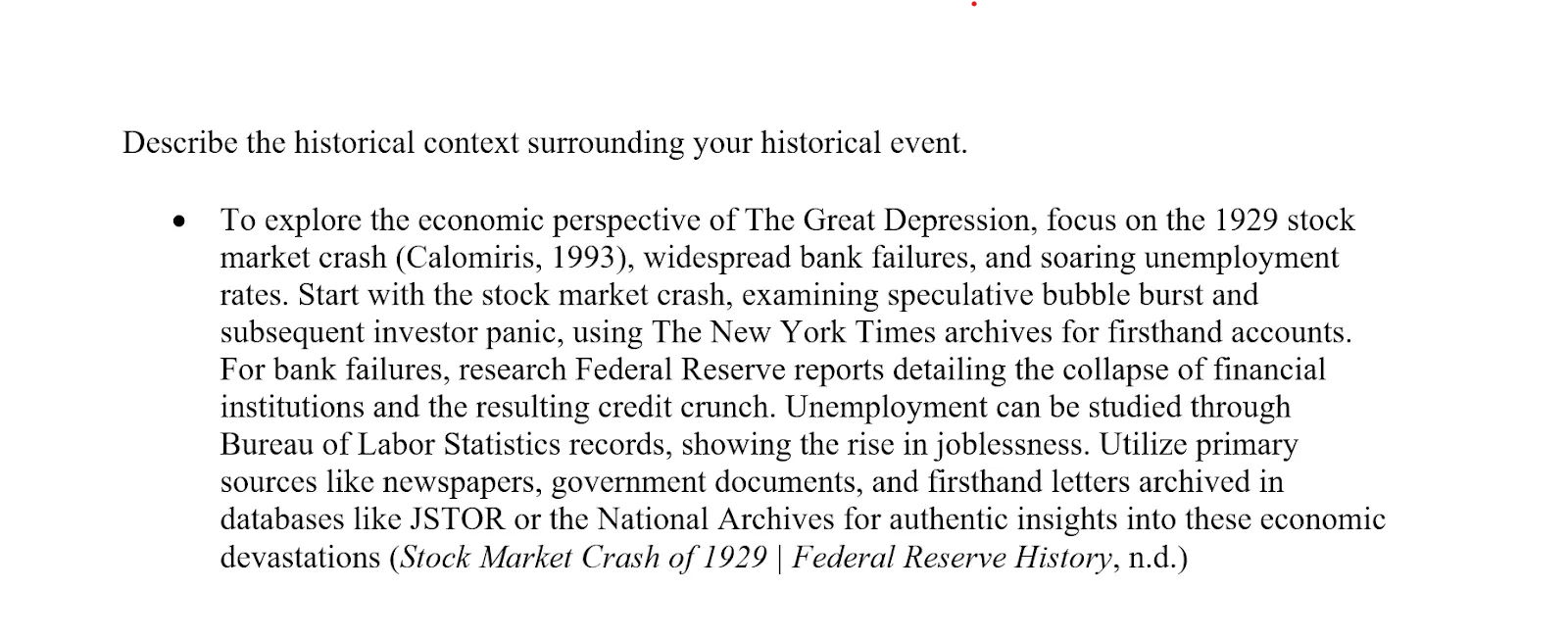
Describe a critical historical figure or group’s participation in your historical event.
Key Figures or Groups During The Historical Event
Now, let us dive into this next section of HIS 100 3-1 Activity: Examining Historical Context, which will focus on the main historical personalities during your chosen historical event.
- Research Key Figures/Groups: Search for personalities or organizations during your selected historical period.
- Analyze Their Roles: Explain what they did during the event and why their actions were important.
Example
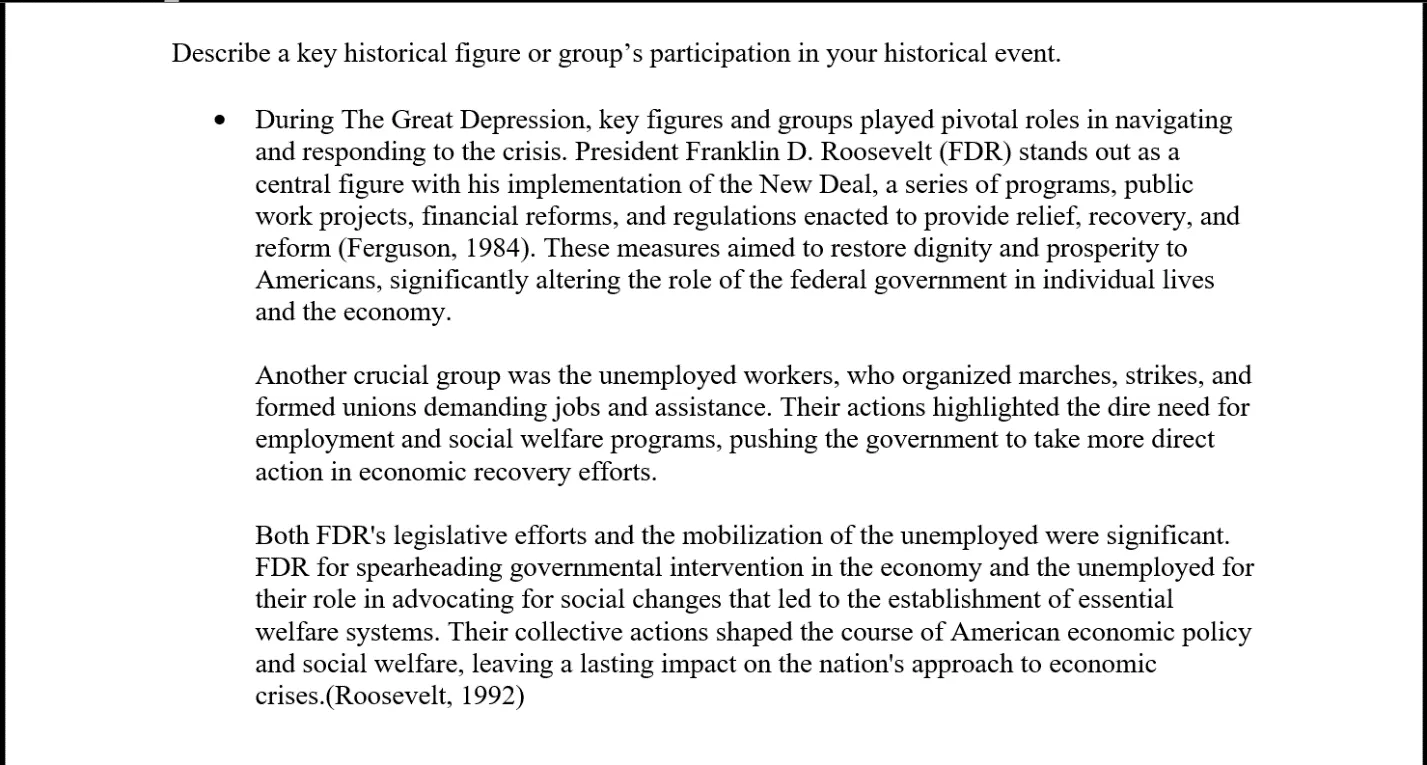
Explain the critical historical figure or group’s motivation to participate in your historical event.
Motivations Behind Participation
Let us explore this section of HIS 100 3-1 Activity: Examining Historical Context, where we will analyze the purpose of the characters ' participation in the historical event chosen.
- Understand Their Beliefs: Research on the epistemology, that is, the systems and beliefs about knowledge in the figures or groups selected. Think through how these beliefs affected them.
- Connect Motivations: To what extent were personal or group motives connected to the greater issues of the economy and society of that period?
Example

Articulate how the historical context caused or influenced your chosen historical event.
The Impact of Broader Society on The Selected Historical Event
In this section of HIS 100 3-1 Activity: Examining Historical Context, it is now the time to analyse the outcomes of various factors in the chosen historical period.
- Analyze Social Conditions: Consider how different aspects of societies—economic, political, religious, beliefs—influenced or were influenced by the occurrences of the event.
- Draw Parallels: Compare these historical social conditions against the current economic realities.
Example
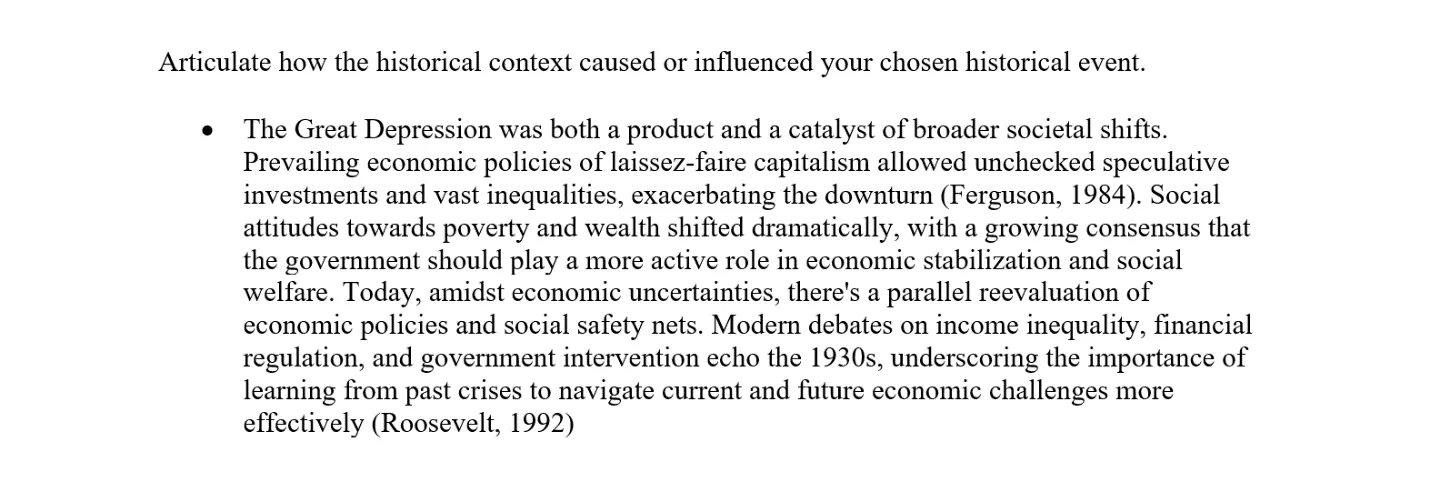
Explain how connecting your historical event and current event improves the understanding of your topic.
Linking Historical and Current Events
The last section of HIS 100 3-1 Activity, Examining Historical Context, will explain the correlation between historical and contemporaneous events.
- Compare Past and Present: Enumerate how the event relates to the current economic issues and differentiate it. Look at aspects such as technology, the politics of the country, and international relations.
- Understand Historical Context: Subsequently, consider how the knowledge of the event can explain some of the features of modern economic challenges.
Example
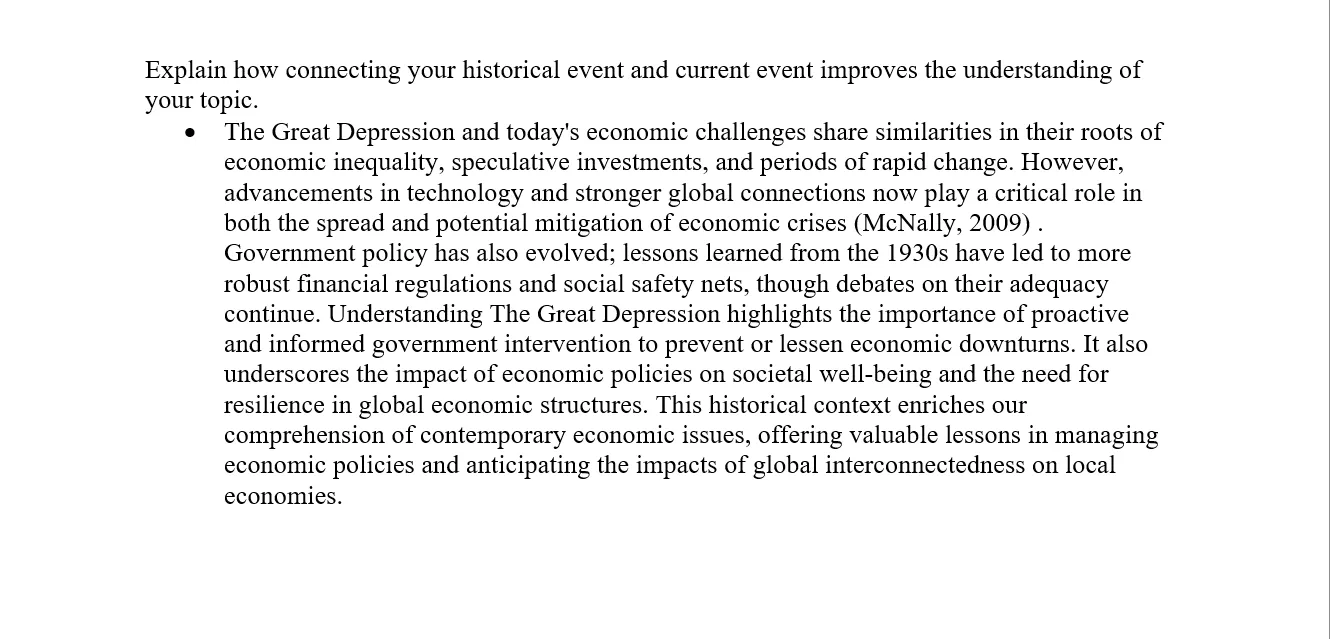
Closing
When analyzing The Great Depression, it is possible to understand that governments, legislatures, economic policies, and societal resilience in addressing economic problems. It is important to take time and learn from history to come up with effective solutions to financial challenges in the present-day world, irrespective of other forces, into a more stable and fair one.
From this guide, you should be able to analyze and understand a historical event you selected from the course HIS 100 in its broad entirety and draw relevant comparisons with current economic realities on the ground. It improves the knowledge of history and develops analytical thinking skills. Good luck!
You can also read our HIS 100 next module, 3-2 Activity: Questions That Can Be Revised with Evidence from Sources.
References
Calomiris, C. W. (1993). Financial Factors in the Great Depression. Journal of Economic Perspectives, 7(2), 61–85. https://doi.org/10.1257/jep.7.2.61
Ferguson, T. (1984). From Normalcy to New Deal: Industrial structure, party competition, and American public policy in the Great Depression. International Organization, 38(1), 41–94. https://doi.org/10.1017/S0020818300004276
McNally, D. (2009). From Financial Crisis to World-Slump: Accumulation, Financialisation, and the Global Slowdown. Historical Materialism, 17(2), 35–83. https://doi.org/10.1163/156920609X436117
Roosevelt, F. D. (1992). FDR’s Fireside Chats. University of Oklahoma Press.
Stock Market Crash of 1929 | Federal Reserve History. (n.d.). Retrieved March 25, 2024, from https://www.federalreservehistory.org/essays/stock-market-crash-of-1929
HIS 100 3-2 activity: revising questions with evidence from sources
Instructions for HIS 100 3-2 activity: revising questions with evidence from sources
Overview
The study of history is guided by asking questions. Developing research questions is an iterative process, which means that the questions are continuously changing as new information is uncovered and new thoughts occur. In this activity, you will consider how historical perspectives and sources influence how research questions are written and revised.
Prompt
Use the Module Three Activity Revising Questions Template Word Document to complete this activity. First, use your primary and secondary sources to help you choose a historical perspective (social, political, or economic) to apply to your topic. Then consider the evidence you have found in those sources, and if that evidence supports your research questions or suggests you need to go in another direction. Finally, you will choose one research question to focus on and revise it. Revising may involve rewriting your research question completely. Or you may need to narrow your focus or improve the clarity of the question.
Example
You initially wanted to research how Native American people and culture have been memorialized in the United States. After consulting sources, you realize that this question is too broad. So, you decide to narrow your question to the movement to change Columbus Day to Indigenous Peoples’ Day. After further research, you decide to approach your topic from a cultural perspective rather than a political perspective. You choose this perspective because you are interested in how Indigenous Peoples’ Day might better preserve and recognize the many Native American cultures (the cultural perspective) rather than how governments have responded to this proposed change (the political perspective).
Specifically, you must address the following rubric criteria:
- Identify a historical perspective that could be applied to your historical event.
- Ensure that you use evidence, such as examples or quotes, from your sources to support why you identified a particular perspective.
- Revise your research question based on evidence from your primary and secondary sources.
- Does the evidence from your primary and secondary sources support your research question, or do they indicate you need to reconsider it? For example, you may need to narrow your focus further or approach your topic from a different perspective. If you do not feel like your research question needs to be changed, explain why.
- Explain how historical perspective and evidence from sources influenced your finalized research
question.
- How did they strengthen or challenge your research question?
Guidelines for Submission
Submit the Module Three Activity Template: Revising Questions. Sources should be cited according to APA style. While references are not required, any sources used should be cited according to APA style if you reference them in your responses. Consult the Shapiro Library APA Style Guide for more information on citations.
Introduction and Step-By-Step Guide For HIS 100 3-2 activity revising questions with evidence from sources
This Owlisdom How-To Guide will be a descriptive and comprehensive explanation of the HIS 100 3-2 activity, revising questions with evidence from sources. I am using the HIS 100 3-2 Activity available at Southern New Hampshire University as an example. If you are taking the Perspective of History course from another institute, the template for this activity has the same directions. This guide comes with a dummy solution of the template for your better understanding.
Identify a historical perspective that could be applied to your historical event. Ensure that you use evidence, such as examples or quotes, from your sources to support why you identified a particular perspective.
Choosing a Historical Perspective
For HIS 100 3-2 activity about revising questions with supporting materials with sources. Initially, we will explore what viewpoint one should select when studying history.
- Define Historical Perspective: Historical perspective is the concept that makes students observe history in terms of social, political, or economic viewpoints.
- Ask yourself what type of thing you would be most excited about. What really matters is the social aspect of family, the political influence, or the economic aspects.
- Use your sources to determine which views are most often examined or have more data provided.
Example

Revise your research question based on evidence from your primary and secondary sources. Does the evidence from your primary and secondary sources support your research question, or do they indicate you need to reconsider it? For example, you may need to narrow your focus or approach your topic differently. If you do not feel your research question needs to be changed, explain why.
Revising Your Research Question
In this section of HIS 100 3-2 activity, revising questions with evidence from sources, we will revise the research question that we came up with in our HIS 100 2-1 activity.
- Is your question too general or specific? Does it enable you to examine the biased point of view that you want?
- To answer your initial question, consider how you can alter your sources to fit the question. For instance, you may develop more precise requirements concerning one aspect of The Great Depression.
- Make your topic too general if it is already specific, or make it too specific if it is too general. Ensure that the question posed is clear and specific.
Example
Deciding how broadly or narrowly to cast your focus on the Great Depression and its impact on the US economy demands critical strategies concerning relevancy. Make sure that your question is so broad that it cannot be answered concisely, yet it is not too specific that it cannot encompass enough information. When preliminary results are negative, it is crucial to reformulate the question in view of any evidence.

Explain how historical perspective and evidence from sources influenced your finalized research question. How did they strengthen or challenge your research question?
Finalizing Your Research Question
We will soon describe how we arrived at the HIS 100 3-2 Activity research question.
- Think about how the evidence from your sources confirms or contradicts your question. Is a change of view necessary?
- Modify your question according to the results you obtained. Ensure that it aligns with your chosen perspective and has data backing it up.
- Briefly describe how the identified perspective and your discovered evidence influenced your research question choice.
Example
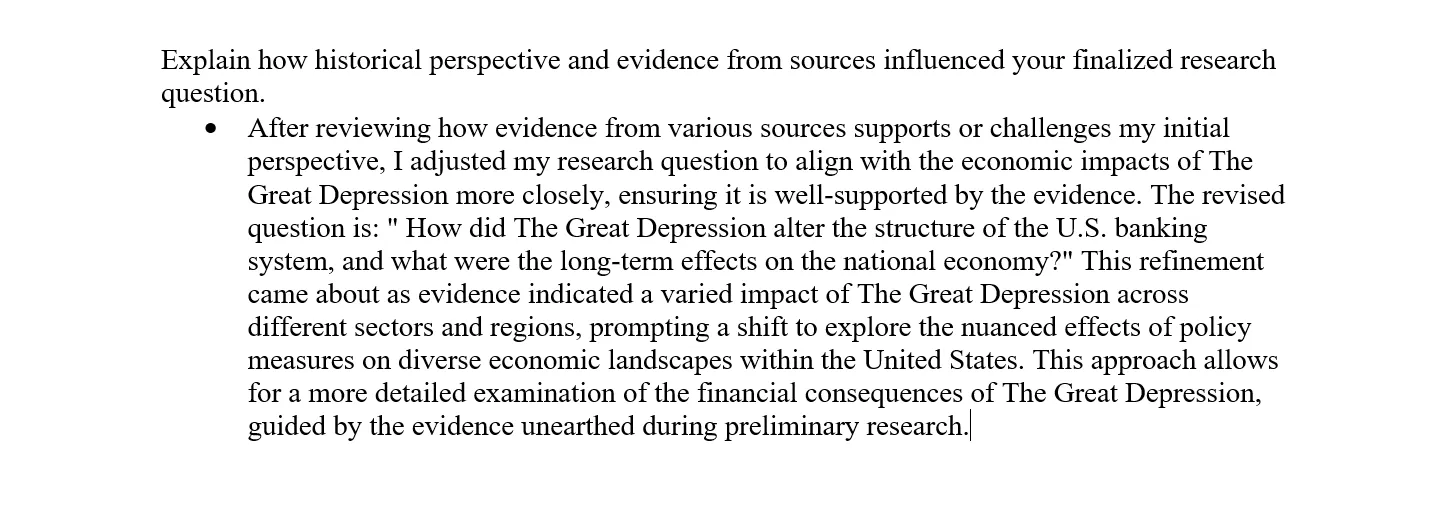
Closing
HIS 100 3-2 Activity: revising questions with evidence from sources.The How-To Guide will help you revise the first formulated research question into a more detailed and clear one. You also need to remember that if the details lead you to a completely different query, it is okay to switch things completely. The idea is to choose a research question you will be able to answer based on the evidence available.
Following this guide is intended to make your approach to completing the assignment as straightforward and clear as possible. Once again, the primary focus when it comes to history is not about discovering the answers, but questioning why we pose those questions in the first place. Good luck!
You can also read our HIS 100 next module, 4-1 Activity: Bias in Primary Sources.
HIS 100 4-1 Activity: Bias in Primary Sources
Instructions for HIS 100 4-1 Activity
Overview
History consists of humans who each have a unique combination of beliefs, assumptions, values, and biases.
The stories we tell and the knowledge we create about the past cannot be separated from their authors.
Thus, we should never accept a source at face value. But instead, we must be critical consumers of information. In this activity, you will analyze your primary sources for narratives and consider if any bias is represented.
Prompt
Use the provided Module Four Activity Template: Bias in Primary Sources Word Document to complete this activity. First, you will locate an additional primary source related to your historical event. Next, you will answer questions about your event and the primary source you identified in a previous module. You will then consider whether there is evidence of bias in these sources.
Specifically, you must address the following rubric criteria:
- Conduct source analysis on two primary sources relevant to your historical event.
- You will respond to specific questions about each source in the activity template.
- Analyze the primary sources relevant to your historical event for the presence of bias.
- What clues are present in your two sources that may indicate bias? Provide evidence of these clues from your sources. If you do not think there is bias, provide evidence to support your claim.
- Compare how your historical event is represented in your primary sources.
- Do the two sources tell the same story, or are contrasting perspectives represented? Provide evidence from your sources.
Guidelines for Submission
Submit the Module Four Activity Template: Bias in Primary Sources. Sources should be cited according to APA style. Consult the Shapiro Library APA Style Guide for more information on citations.
Step-by-Step Guide and Introduction to HIS 100 4-1 Activity: Bias in Primary Sources
This Owlisdom How-To Guide will provide a descriptive and detailed overview of the HIS 100 4-1 Activity: Bias in Primary Sources. It will assist you in grasping the notion that another person with a different perception is behind every historical record or source. This implies that these may display bias or a propensity to incline toward a particular approach associated with belief systems. Of course, it is crucial to present these sources critically to get a much better idea of what has actually happened.
Source 1
Roosevelt, F. D. (1933). Fireside Chat 1: On the Banking Crisis. National Archives. https://elischolar.library.yale.edu/cgi/viewcontent.cgi?article=12267&context=ypfs-documents
Source 2
Lewis, F. (2003, October 30). Headlines in the newspaper, “The Philadelphia Inquirer,” relate to the… Getty Images. https://www.gettyimages.com/detail/news-photo/headlines-in-the-newspaper-the-philadelphia-inquirer-relate-news-photo/2681929
Conduct source analysis on two primary sources relevant to your historical event. You will respond to specific questions about each source in the activity template.
Source Analysis
In this section of HIS 100 4-1 Activity: Bias in Primary Sources, we will complete the questions of the template 4-1 Activity.
Analysis of Primary Source 1
Analysis of Primary Source 2
Analyze the primary sources relevant to your historical event for the presence of bias. What clues in your two sources may indicate bias? Provide evidence of these clues from your sources. Provide evidence to support your claim if you do not think there is bias.
Identifying Bias in Primary Sources
Let us focus on this next HIS 100 4-1 Activity: Biases present in primary sources section.
- Look for clues of bias. Is there any word or phrase that supports one or the other party?
- Look at the options of the person who is making the creations. Is there already evidence from their profession or personal background that they may have a certain bias?
- Challenge bias by citing fragments of the sources opposite to the biased statement made. If you think there is none, tell us why using facts and figures.
Example
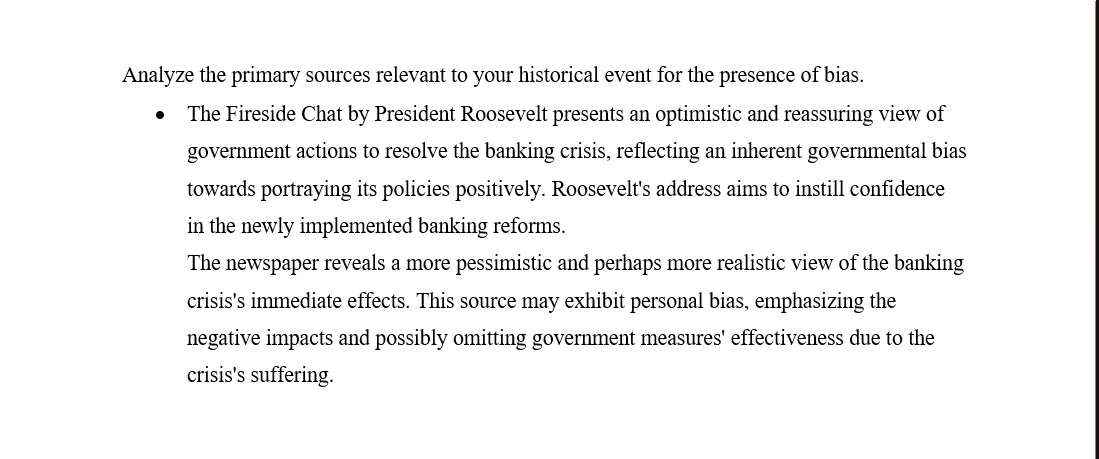
Compare how your historical event is represented in your primary sources. Do the two sources tell the same story, or are contrasting perspectives represented? Provide evidence from your sources.
Comparing Historical Event Representations
In this next section of HIS 100 4-1 Activity: Bias in Primary Sources, we will examine the bias between the two sources and the related events.
- Describe all eventual dissimilarities or resemblances that still exist between the two sources about the transformation in the American banking system and the gross repercussions on the economy.
- Use observations from both sources to address the following assessment questions. Is the picture varied, or is it the same picture?
Example
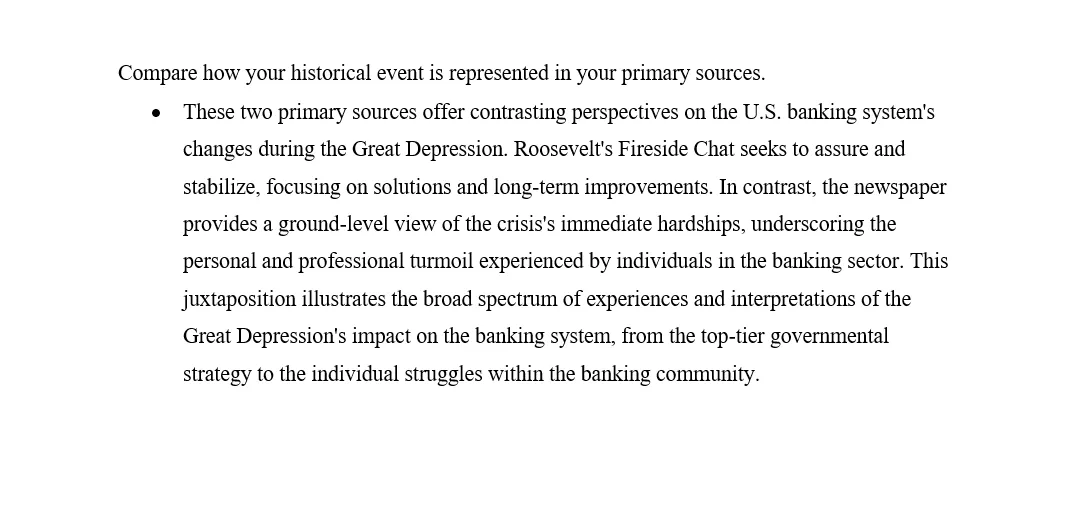
Closing
This guide will assist you in doing well in HIS 100 4-1 Activity, Bias in Primary Sources. Good luck!
You can also read our next HIS 100 chapter: Module 4-2 Activity: Analyzing historical narratives.
HIS 100 4-2 Activity: Analyzing historical narratives
Instructions for HIS 100 4-2 Activity
Overview
Each historical event was experienced, perceived, and remembered differently depending on the person, which means there are many competing narratives of a single event. In this activity, you will compare the narratives represented in each of your sources.
Prompt
Use the provided Module Four Activity Template: Historical Narratives Word Document to complete this activity.
First, you will locate an additional secondary source related to your historical event. You will then compare the narratives about your historical event in each of your sources (two primary and two secondary). Finally, you will choose a narrative you believe has been the most influential in terms of what is known about your historical event.
Specifically, you must address the following rubric criteria:
- Compare the narratives presented in your primary and secondary sources relevant to your
historical event.
- Apply the source analysis skills from the previous activity to help you compare the narratives about your
historical event. Describe the stories told in each source about your historical event. Provide evidence
from your sources to support your descriptions of the narratives. Consider the following questions:
- How are the narratives in each source similar and/or different?
- How has the story of your historical event and key figure or group (identified in the previous module) been told in the past and the present?
- From which perspectives are the narratives told?
- What was occurring in society at the time of the event, such as politics, the economy, and entertainment?
- Apply the source analysis skills from the previous activity to help you compare the narratives about your
historical event. Describe the stories told in each source about your historical event. Provide evidence
from your sources to support your descriptions of the narratives. Consider the following questions:
- Describe one narrative that has significantly influenced the contemporary understanding of your
historical event.
- Select one narrative from the four you analyzed. Choose the narrative that you think has been the most influential in terms of what is known and unknown about your historical event. Explain why you chose this narrative and how it has impacted our current understanding of the event.
- Explain how the chosen narrative helps you better understand your historical research question.
- How does the narrative you chose expand, support, or challenge your research question?
Guidelines for Submission
Submit the Module Four Activity Template: Historical Narratives. Sources should be cited according to APA style. Consult the Shapiro Library APA Style Guide for more information on citations.
Step-By-Step Guide to HIS-100 4-2 Introduction to Activity: Analyzing Historical Narratives
This Owlisdom How-To Guide will provide a descriptive and detailed overview of the HIS 100 4-2 Activity: Analyzing Historical Narratives. In Module Two of HIS 100, the historical narratives of the primary and secondary sources that were selected in previous activities are assessed. I use the template for the HIS 100 4-2 Activity of Southern New Hampshire University as an example. In case you are taking the Perspective of History course from another institute, the outline for this activity would be almost similar to the above assembly. This guide will give you a dummy solution for the HIS 100 4-2 activity template, historical narratives.
Compare the narratives in your primary and secondary sources relevant to your historical event.
Comparing Narratives in Primary and Secondary Sources
The HIS 100 4-2 Activity: Analyzing Historical Narratives, historical narratives will be compared by the use of primary sources and secondary sources.
- Overview of Narratives
- Similarities and Differences in Narratives
Example
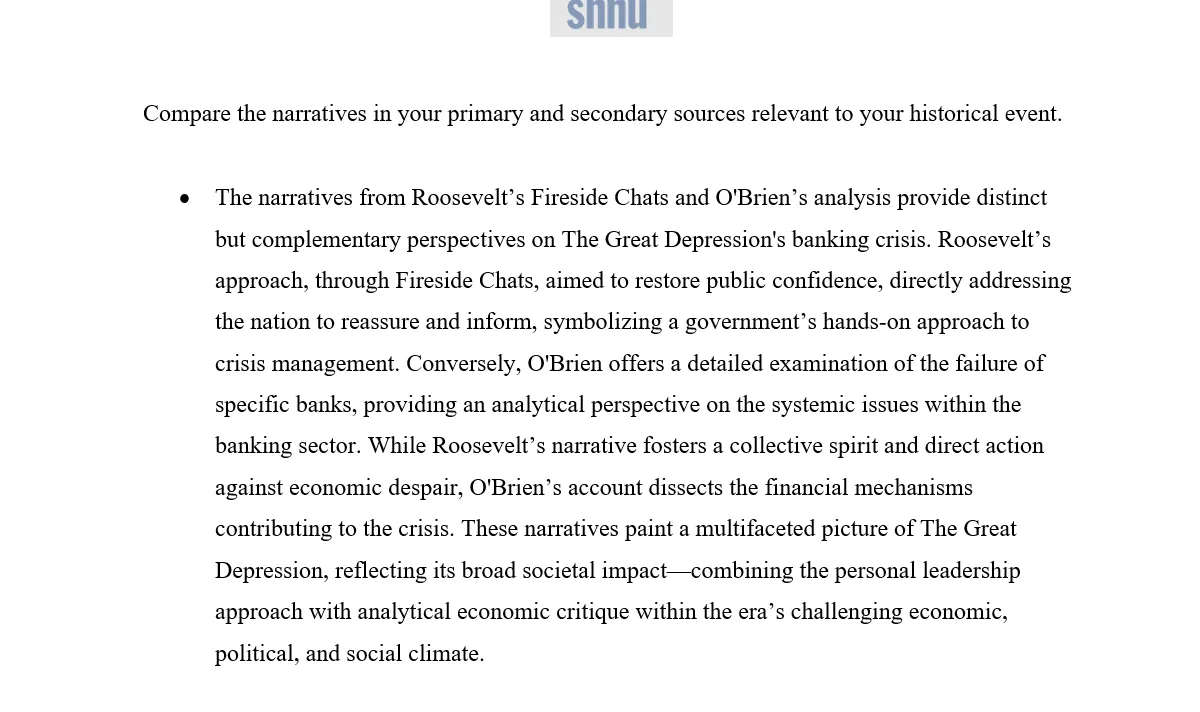
Describe one narrative that has significantly influenced the contemporary understanding of your historical event.
Selecting and Describing an Influential Narrative
We will discuss selecting and describing the influential narratives we used for HIS 100 4-2 Activity: Analyzing Historical Narratives.
- Select one narrative you feel is most valuable in creating today’s concerns: The Great Depression.
- Explain why this is your favourite piece of narrative. Look under the consideration of its coverage, effects, and the testimonies it produces.
.
Example
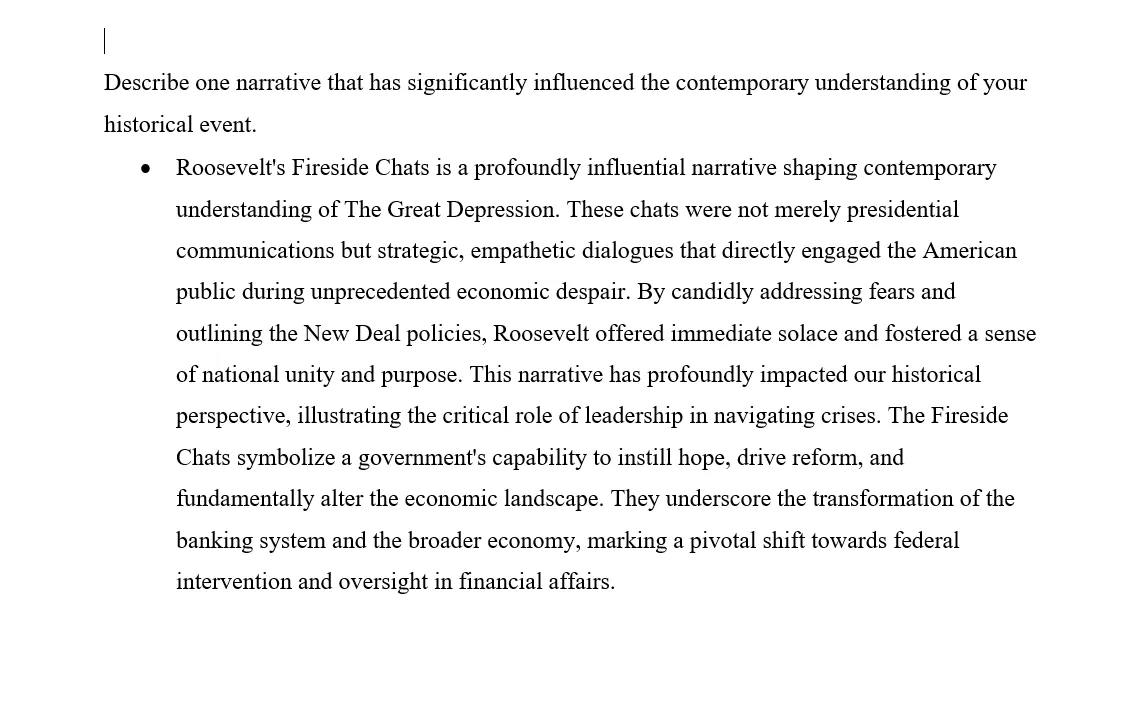
Explain how the chosen narrative helps you better understand your historical research question.
Explaining the Chosen Narrative’s Impact
In this section of HIS 100 4-2 Activity: Analyzing Historical Narratives, we will discuss the outcomes of the narratives selected.
- Explain how the selected story has impacted your present perception of your historical event. Does it show what led to it, what followed, or what can be learnt from it?
- Consider in what way these narratives enhance, enrich or complicate your research question.
Example
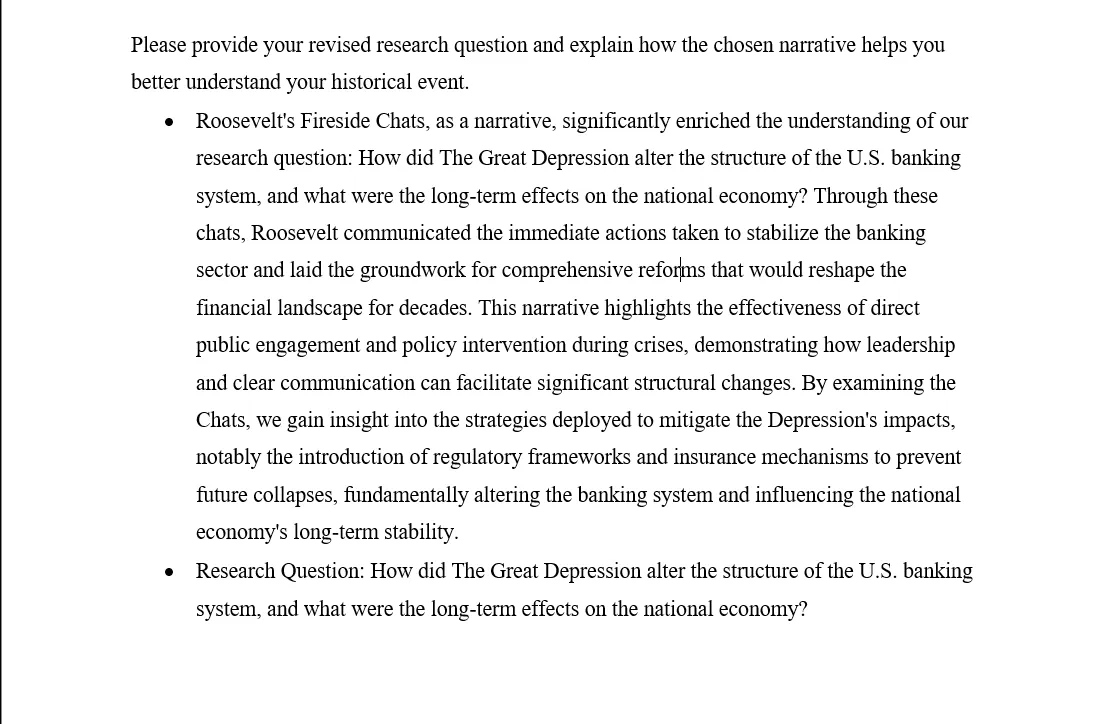
Closing
Following these steps and critically analyzing the narratives from primary and secondary sources for HIS 100 4-2 Activity: Analyzing Historical Narratives, it will help in analyzing narratives from history. I wish you to better understand the historically significant event, which you have chosen, as well as the problem of historical analysis. Good luck!
You can also read our HIS 100 next module, 5-1 Discussion: Uncovering Bias and Missing Narratives.
HIS 100 5-1 Discussion: Uncovering Bias and Missing Narratives
Instructions for HIS 100 5-1 Discussion
Thus far, you have learned how historical contexts, perspectives, and biases influence the interpretation and " telling; of historical narratives. For this discussion, reflect on what you have learned about your research question and the historical event and current event you chose. To ensure an interesting discussion, you are encouraged to think creatively about your initial posts and extend the points made by your peers. It is also important to review the module resources and read the prompts in their entirety before participating in the discussion. You should include examples and other supporting evidence from the module resources in your posts. Discussing challenges that face our world often means investigating opinions and ideas different from your own. Remember to remain thoughtful and respectful towards your peers and instructor in your discussion post and replies.
Create one initial post and follow up with at least two response posts.
For your initial post, address the following:
- Discuss the brainstorming process you used to identify bias in your primary and secondary sources. How did you
do it? Describe the strategies that were successful for you.
2. Consider the challenges you encountered in identifying the narratives about your historical event. What methods did you use to identify the absent voices in the historical narratives?
3. What perspectives do you think are missing from the narrative about your historical event? Be sure to cite evidence from your sources to justify your points.
For your response posts, address the following:
- How might you use your peers' strategies to uncover another absent perspective related to your historical event or expose a historical narrative bias? If you think you cannot apply your peers' strategies to your own event or narrative, explain why. Remember, this assignment is graded on the quality of your initial post and at least two response posts to your classmates. If you refer to any module resources, be sure to include an attribution (or citation) for the resource.
To complete this assignment, review the Discussion Rubric.
Step-By-Step Guide And Introduction to HIS 100 5-1 Discussion: Uncovering Bias and Missing Narratives
This Owlisdom How-To Guide will provide a descriptive and detailed overview of the HIS 100 5-1 Discussion: Uncovering Bias and Missing Narratives. As we explore the aspects of this discussion, it is essential to understand what we are to do here, as I mentioned in the previous section: 5-1 Discussion concerns the analysis of how historical context and bias inform the interpretation and narratives of history. We engage these aspects analytically through the use of historical and current dimensions.
Reminder: All the assignments and tasks of HIS 100 are related.
Discuss the brainstorming process you used to identify bias in your primary and secondary sources. How did you do it? Describe the strategies that were successful for you.
Identifying Bias in Sources
Let us delve into this section of HIS 100 5-1 Discussion: Uncovering Bias and Missing Narratives, describing how to analyze the sources searched for the previous activities.
Start Simple: Start with your assumptions about the topic, write down all the prior knowledge, and then ask yourself doubts. Seek Multiple Sources: For a broader view, search for different sources like books, articles, and documentaries. Compare Narratives: Notice how similar stories can look at the same event from different sources. It is important to find differences because differences can betray adversary prejudices. Check the Source’s Background: Understand the author of the data and the possible reasons for distributing this knowledge. Look for What’s Not Said: Whenever something is excluded from a list, the reasons for its exclusion may, in fact, tell a lot about bias.
Consider the challenges you encountered in identifying the narratives about your historical event. What methods did you use to determine the absent voices in historical narratives? What perspectives need to be added to the narrative about your historical event?
Challenges in Historical Narratives
In HIS 100 5-1 Discussion: Uncovering Bias and Missing Narratives. It is now the time to discuss the issues encountered when studying historical discourses.
Research Marginalized Groups: These are voices that are frequently silenced. Sources that are likely to give a different angle should be sought out. Ask Critical Questions: Whose story isn’t being told? Why might that be? Think Outside the Box: Look into views that are completely missing out. Is there another way of looking at the matter simply because of a person’s social class, gender, or ethnicity? Use Evidence to Support: Whenever you fail to see a perspective, support it by presenting your findings as evidence.
How might you use your peers’ strategies to uncover another absent perspective related to your historical event or expose a historical narrative bias? If you think you cannot apply your peers’ approach to your event or narrative, explain why.
Engaging in Discussion
To promote interaction and the sharing of helpful information, it is important to respond to and address peers’ questions. However, there are times when we have to start answering questions more directly and formally. Some HIS 100 5-1 Discussion: Uncovering Bias and Missing Narratives posts might require using peers’ responses. As a result, here are guidelines on how to answer any question:
Be Creative: One must begin with a sound and provocative point. Apply all you’ve learned so far to write a fresh post encouraging discussion. Include Examples: It is imperative that you use your research to back your points in your paper. Extend the Conversation: Put forward the development of the ideas of your peers, provide new perspectives or engaging questions. Be Respectful and Thoughtful: Please remember that the main purpose of the discussion is to share knowledge with one another regardless of our opinions.
Response 01
The way you have presented the research to identify the hidden agendas in the various consequences of the Great Depression on the U.S. banking system is very informative. This led me to begin to consider the established accounts of urban workers and rural farmers during this time (Boyd, 2002). Discrimination based on gender and race is important to cushion, but could you classify the impacts under a marginal group, and how urban workers were affected by bank failures differently from other rural groups? These workers had saved their money in banks and used it to transact daily businesses. At the same time, credit was a major source of funding for small businesses, which could give another perspective to the restructuring process of the banking system. It might uncover more regarding the social and economic consequences for various urban and rural groups and paint an even more detailed picture of the depression’s consequences.
References
Boyd, R. L. (2002). Urban unemployment, the rural labor market, and southern blacks in farm labor during the Great Depression: A research note. The Social Science Journal, 39(2), 295–299. https://doi.org/10.1016/S0362-3319(02)00170-2
Response 02
According to the instructions of HIS 100 5-1 Discussion: Uncovering Bias and Missing Narratives, two or more peer responses should be written to the assignments. I have posted my response to the instructions in one response only. Following these instructions, you can quickly and professionally write your peer responses.
Closing
Following these guidelines, you can complete the task responsive to the discussion post and improve your understanding of how to learn more and give a richer meaning to the topic of bias and missing narratives in historical research. I hope you nail this HIS 100 5-1 Discussion: Uncovering Bias and Missing Narratives. Good luck!
You can also read our HIS 100 next module, 5-2 Activity of Historical Interpretations of Past and Present.
HIS 100 5-2 Activity: Historical Interpretations of Past and Present
Instructions for HIS 100 5-2 Activity
Overview
Over the past few weeks, you have examined how context, perspective, and bias impact what we know about history and how we talk about it. You also started to make connections between your research question, historical event, and current event. In this activity, you will build upon that work to consider the historical roots of your current event and what the narratives would be like if told from a different perspective.
Prompt
Use the provided Module Five Activity Template: Historical Interpretations Word Document to complete this activity. First, you will reflect on the process of researching the subject of your historical research question and its connection to your current event. You will then consider the impact of bias on our existing knowledge. Finally, you will address how the narratives about your historical and current events would change if told from alternative viewpoints.
Specifically, you must address the following rubric criteria:
Describe how exploring your research question improved your understanding of the historical roots of your current event. How did learning more about the subject of your research question help you identify events from the past that contributed or led up to your current event? Explain how biased perspectives influence what is known about both your historical and current events. Support your points with relevant course resources. Propose how the narrative about your historical event might change if it were told from a missing perspective. Refer to the missing perspective you identified in this week’s discussion. How might this point of view change the story about your historical event? For example, would the narrative focus on different details, or would those details be interpreted differently? Propose how the narrative about your current event might change if it were told from a missing perspective. Expand on the missing perspective from criteria three and apply it to your current event. How might your current event be understood differently by examining it from that perspective?
Guidelines for Submission
Submit the Module Five Activity Template: Historical Interpretations. Sources should be cited according to APA style. Consult the Shapiro Library APA Style Guide for more information on citations.
Introduction and Step-By-Step Guide For HIS 100 5-2 Activity Historical Interpretations of Past and Present
HIS 100 5-2 Activity: Historical Interpretations of Past and Present, this Owlisdom How-To Guide walks you through understanding how context, perspective, and bias can affect history, and more specifically, how The Great Depression impacted the U.S. banking system and its long-term effects on the national economy in its past.
Describe how exploring your research question improved your understanding of the historical roots of your current event.
Impact of Learning About the Historical Event Selected
In HIS 100 5-2 Activity: Historical Interpretations of Past and Present, let’s discuss if learning about the historical research topic chosen has had an impact.
Identifying Historical Roots
By researching the event, you were able to figure out how it had affected the U.S. banking system. Tell a specific past event that connects to the current economic expansion issue.
Example
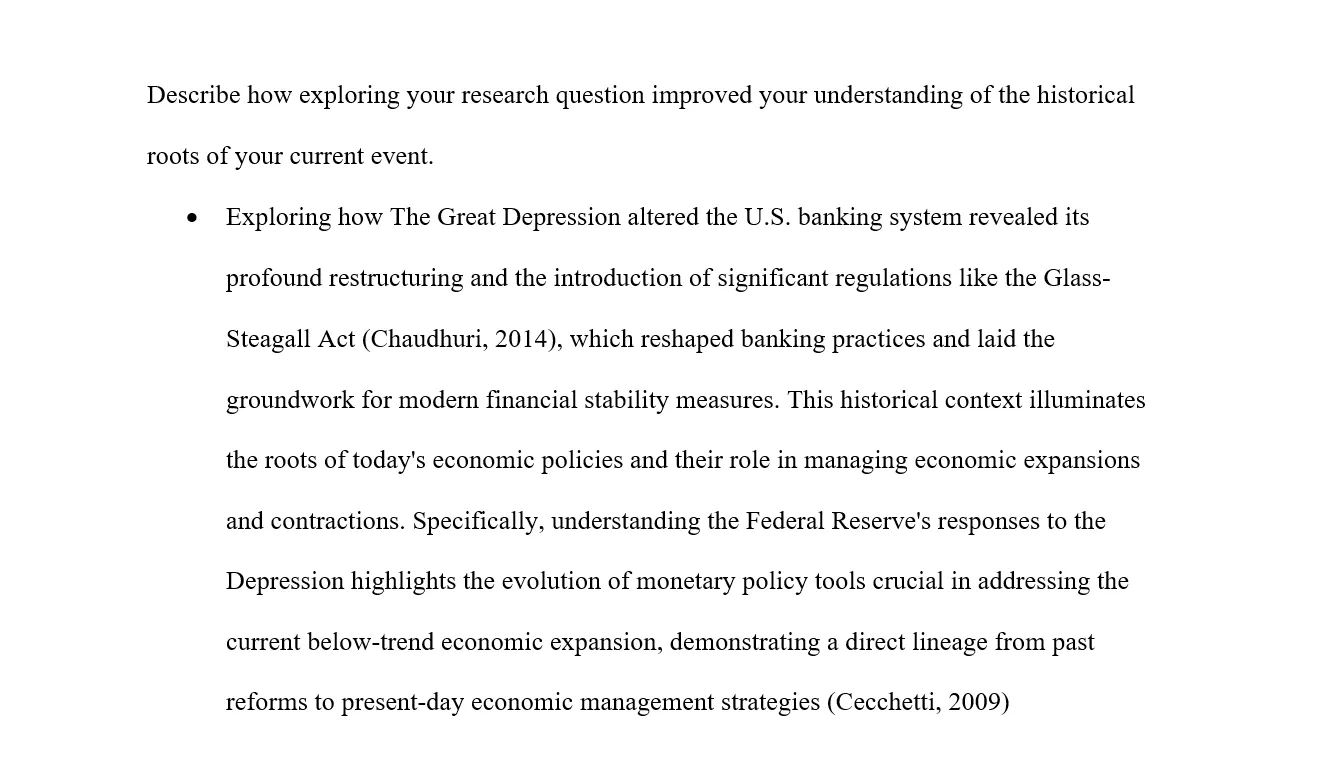
Explain how biased perspectives influence what is known about both your historical and current events.
Influence of Bias
Let us explore the influence of bias on historical research in HIS 100 5-2 Activity: Historical Interpretations of Past and Present.
On Historical Events
Consider how bias might have contributed to what we know or do not know about The Great Depression. Back it up with examples from the course resources.
On Current Events
Describe how narratives of bias may affect a broader understanding of the current economic situation. Give some examples that illustrate how perception can be influenced by bias.
Example
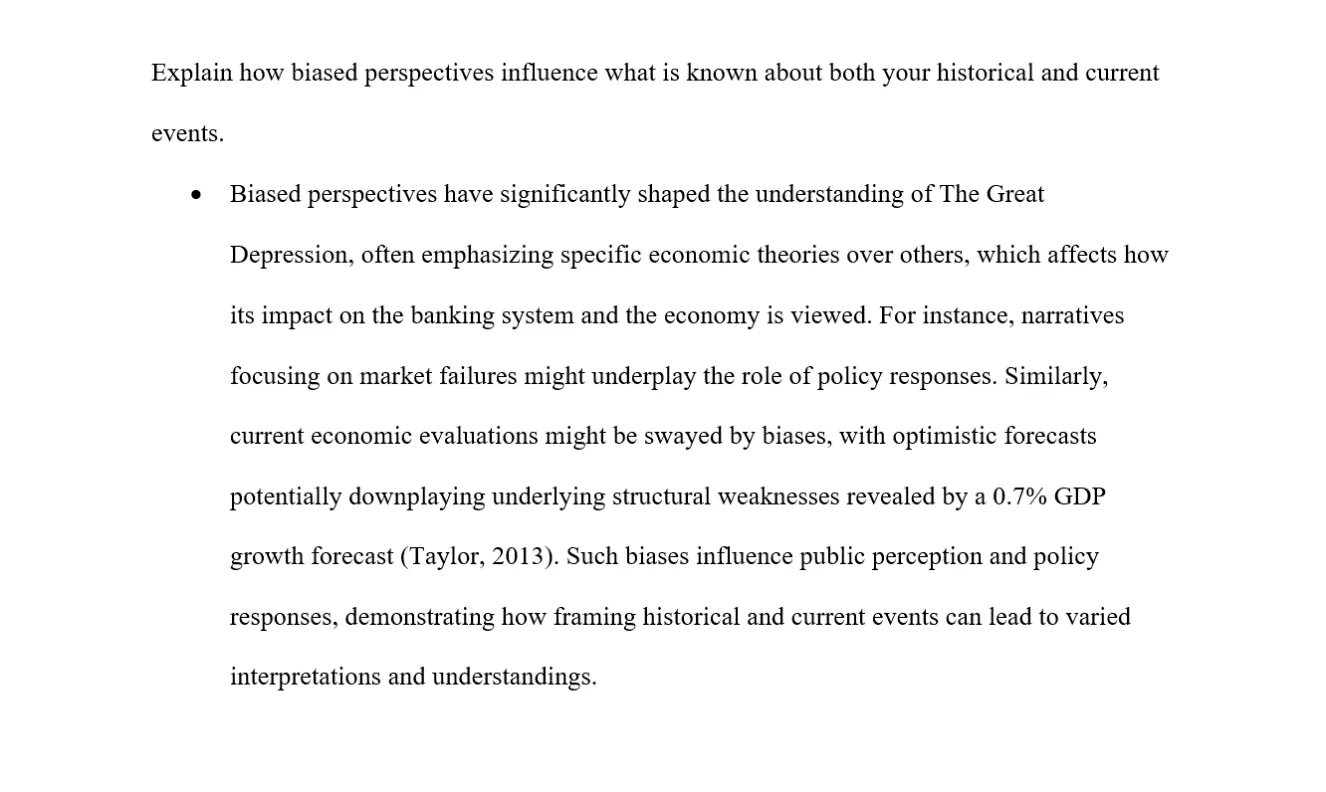
Propose how your historical event’s narrative might change if told from a missing perspective. Propose how the narrative about your current event might change if told from a missing perspective.
Alternative Perspectives
Discuss this next section of HIS 100 5-2 Activity: Historical Interpretations of Past and Present.
On Historical Events
Find a perspective that is missing from your research in The Great Depression. Try to imagine what the narrative might have been if told from this perspective. Instead, think of what other details you can pay attention to and how you could interpret those known details differently.
Example
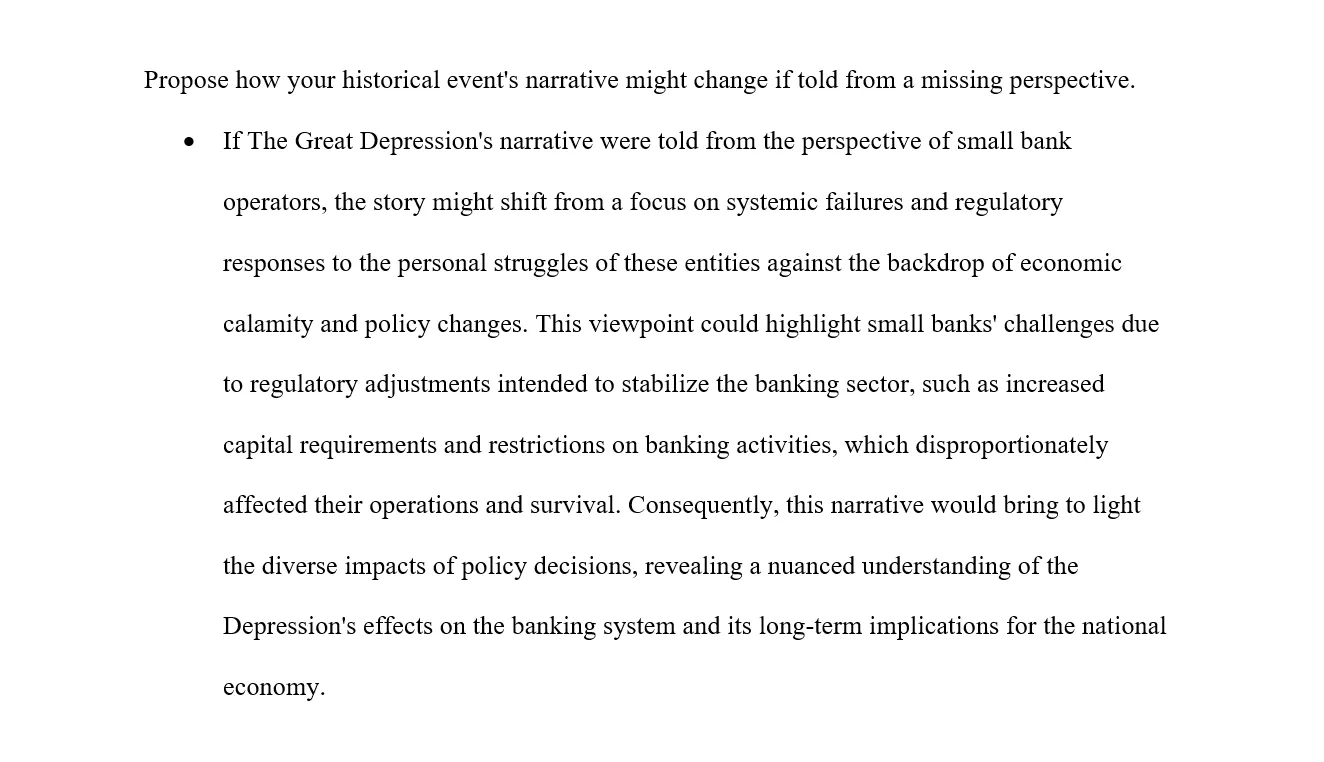
On Current Events
Take the current economic situation and expand on the missing perspective identified earlier. Talk about how knowing this helps to change the narrative or perception of current events.
Example
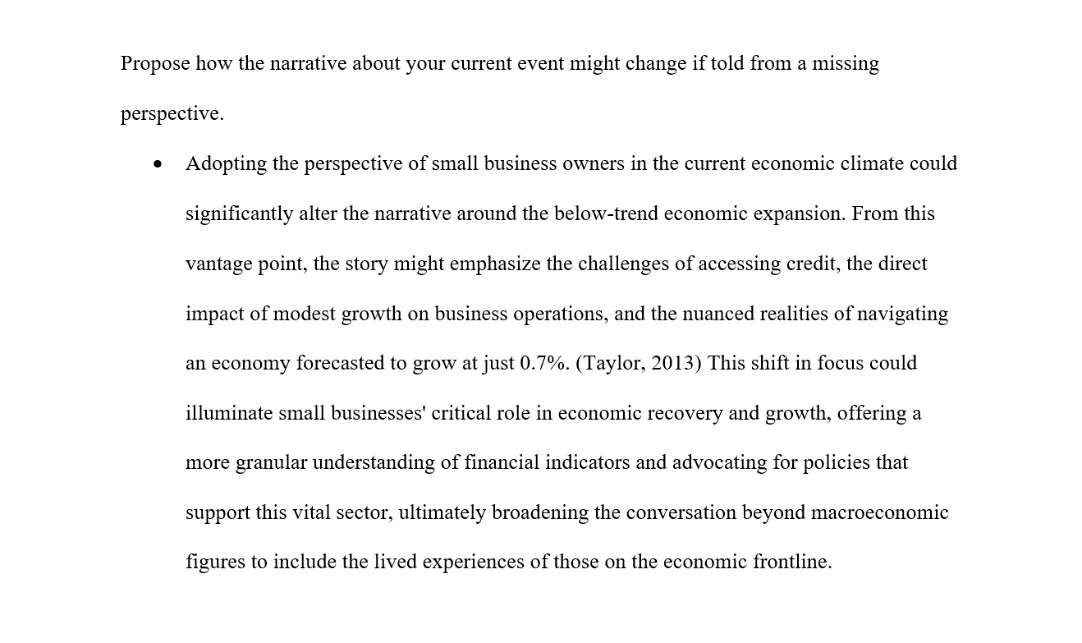
Closing
This how-to guide helps you understand how different perspectives and biases influence the interpretation of history and other events. I hope you smash the HIS 100 5-2 Activity: Historical Interpretations of Past and Present. Good luck!
You can also read our HIS 100 next module, 6-1, discussion of responsibility to be historically informed.
References
Cecchetti, S. G. (2009). Crisis and Responses: The Federal Reserve in the Early Stages of the Financial Crisis. Journal of Economic Perspectives, 23(1), 51–75. https://doi.org/10.1257/jep.23.1.51
Chaudhuri, R. R. (2014). The Great Depression and the Glass-Steagall Act. In R. R. Chaudhuri (Ed.), The Changing Face of American Banking: Deregulation, Reregulation, and the Global Financial System (pp. 71–82). Palgrave Macmillan US. https://doi.org/10.1057/9781137361219_6
Taylor, A. M. (2013). The Great Leveraging. In The Social Value of the Financial Sector: Vol. Volume 29 (pp. 33–65). WORLD SCIENTIFIC. https://doi.org/10.1142/9789814520294_0004
HIS 100 6-1 Discussion: The Responsibility to be Historically Informed
Instructions for HIS 100 6-1 Discussion
Throughout the course, you have examined how historical events impact current events. Historians are often motivated to study the past because that knowledge can help us frame, compare, and understand modern problems. However, what responsibilities does an ordinary citizen have to know a particular history (such as different historical perspectives, different historical times, and different geographical regions) or to have the skills to study history effectively?
Discussing challenges that face our world often means investigating opinions and ideas different from your own. Remember to remain thoughtful and respectful towards your peers and instructor in your discussion post and replies.
Create one initial post and follow up with at least two response posts.
For your initial post, address the following:
Discuss what responsibilities, if any, citizens should have related to being historically informed. For example, what historical inquiry skills might be important for a citizenry to have to address current global challenges? Think about a challenge, opportunity, event, or issue that affects your community. How might being more historically informed impact how you understand that issue or how you take action?
For your response posts, address the following:
What perspectives did your peers offer that you had not considered previously regarding the value of a historically informed population? Share other ways being more historically informed could help your peers understand or act on the community issue they identified.
Remember, this assignment is graded on the quality of your initial post and at least two response posts to your classmates. If you refer to any module resources, be sure to include an attribution (or citation) for the resource.
To complete this assignment, review the Discussion Rubric.
Step-By-Step Guide and Introduction to HIS 100 6-1 discussion, the responsibility to be historically informed
This Owlisdom How-To Guide will help you through the HIS 100 6-1: Responsibility to be historically informed. It discusses how being historically informed citizens is important and how history can change our views and actions.
Discuss what responsibilities, if any, citizens should have related to being historically informed.
The Importance of Being Historically Informed
The first section of the HIS 100 6-1 discussion will discuss the responsibility of being historically informed.
- Why should citizens know about history? Think of democracy, informed voting, and social empathy.
- Describe and list the critical skills required to understand history well, including how to use your critical thinking, critique sources for bias, and compare historical perspectives.
Example
What matters is not just knowing dates and events in history. It’s about being informed to build an informed, empathetic, active citizenry. Why? Our votes in a democracy shape the future (Welzel, 2021). History teaches us what the policies and leaders we elect will be, not just what they say, but how they will act as a result of history. It is like you can figure out potentially the ending of a movie you have seen a thousand times.
History also shows us empathy (Kohut, 2020). We learn better about the struggles and triumphs of various people at different times and can empathize and help one another more.
Critical skills in history include critical thinking, questioning, connecting historical facts, scrutinizing sources for bias because every story tells one side, and also comparing perspectives to see the whole picture. These skills enable us to filter through the noise to uncover truths that help guide our decisions and beliefs.
Think about a challenge, opportunity, event, or issue that affects your community. How might be more historically informed approach impact how you understand that issue or take action?
Impact on Understanding Community Issues
We continue in HIS 100 6-1 discussion of the responsibility to be historically informed, as it is imperative to understand the challenges a community within history faces.
- Pick a local issue (e.g., environmental, housing, or education) and briefly write about it.
- Discuss why historical knowledge about the problem can help us understand it better or perhaps provide a solution.
Example
The lack of affordable housing is a big deal in our community. Rent is out of control, and people are getting pushed out of neighborhoods they have spent years paving a path in. It is about buildings, families, memories, and roots.
Underlying today’s housing landscape—redlining, urban renewal, and more—have had a heavy impact (Nardone et al., 2020). These policies worked against some interests which resulted in long-term inequality in housing access and quality.
Such understanding can alter our view of the issue. But it’s about more than market forces — it’s about how we can start making different choices in the past. With that knowledge, we can use it to fight for policy that changes these imbalances and prevents these imbalances from happening again. It demonstrates the effect of informed action on a brighter future.
What perspectives did your peers offer that you had yet to consider regarding the value of a historically informed population? Sharing other ways of being more historically informed could help your peers understand or act on the community issue they identified.
Response to Peers
In this portion of the HIS 100 6-1 discussion, responsibility to be historically informed, we discuss how to engage with peers and respond to their questions.
- Think about something you learned from your peers’ posts that was new to you.
- Reflect on what it would take to be more historically informed, and share how this would help your peers better understand the community issue that you identified.
Example
I resonated with your insight about learning from history to tackle today’s challenges, such as housing. It’s eye-opening to see that history can be a sort of roadmap for how to deal with present situations (Koulisis, 2022). With a look at how previous communities overcame similar challenges, there are actionable strategies that will work today. This approach holds hope and solutions that point us through the present and future instead of being lost in an endless circle of the past. The practical side of history that is helping us shape better responses to present problems was underlined by your perspective.
Reference
Koulisis, O. (2022). Meet Me in the Classroom: History Surveys for Democratic Politics. Journal of American History, 108(4), 779–787. https://doi.org/10.1093/jahist/jaac006
Closing
With this guide, you will be able to articulate what being historically informed entails, the significance of surveying history, and how historical awareness may help solve contemporary problems. I hope you do well in the HIS 100 6-1, responsibility to be historically informed. Good luck!
We can also read HIS 100 next module 7-1 project submission.
References
Kohut, T. A. (2020). Empathy and the Historical Understanding of the Human Past. Routledge. https://doi.org/10.4324/9780367853648
Nardone, A., Chiang, J., & Corburn, J. (2020). Historic Redlining and Urban Health Today in U.S. Cities. Environmental Justice, 13(4), 109–119. https://doi.org/10.1089/env.2020.0011
Welzel, C. (2021). Why the Future Is Democratic. Journal of Democracy, pp. 32, 132.
HIS 100 7-1 Project Submission
Instructions for HIS 100 7-1 Project Submission
Overview
Study the past if you would define the future.
—Confucius
Many people argue that we are products of our past. However, as the Chinese philosopher Confucius suggested, because the contemporary events taking place around us have histories, we can examine them to understand how and why the events came to be. By developing the skills needed to investigate those histories, we can uncover the historical roots of current events and learn from them. Researching, examining narratives, uncovering personal biases, and finding credible resources are some of those skills. We might not want to be historians in the future, but we should all understand how to look at things from a historical standpoint to better understand contemporary issues.
For this project, you will choose a historical event to explore from the Library Research Guide. These events fit into the topic areas of:
- Inequality and human rights
- Political revolutions
- Climate change
- Globalization
Directions
Read these directions and the rubric criteria and reach out to your instructor if you have any questions before you begin working on this project. Many of the steps below will require you to reference and utilize the work you have done in previous modules of this course. You may use the provided template to complete this project or choose not to use the template and submit a Word document instead.
Part 1: Creating a Research Question:
The quality of research often depends on the quality of the question driving it. It is important to understand how personal opinions, perspectives, and historical sources all play a part in developing and examining a research question. Complete the following steps to discuss how you developed a strong research question about your chosen historical event.
- Describe how your assumptions, beliefs, and values influenced your choice of topic.
- How might your own perspectives and opinions impact the topic you chose and how you may approach studying it?
- Discuss the significance of your historical research question in relation to your current
event.
- State your historical research question and explain the connection between your current event and your question.
- Explain how you used sources to finalize your research question.
- Identify the specific primary and secondary sources you used.
- Discuss how evidence in these primary and secondary sources strengthened or challenged the focus of your question.
Part 2: Building Context to Address Questions:
In this part of the project, you will examine the historical context related to your historical event. The context will be like snapshots that capture what was happening in history that affected the development of your current event.
- Describe the context of your historical event that influenced your current event.
- How does the context of your historical event help tell the story of what was happening at the time? How might this historical event connect or lead to your current event?
- Describe a historical figure or group’s participation in your historical event.
- This person or people must have directly participated in the event you identified as it was happening, not after it.
- Use specific details from your primary and secondary sources to demonstrate how the person or people participated in the event.
- Explain the historical figure or group’s motivation to participate in your historical
event.
- Consider why the person or people were motivated to get involved in the event.
Part 3: Examining How Bias Impacts Narrative: Narrative is how people tell stories based on their own assumptions, beliefs, and values. From a historical perspective, narratives influence who we focus on, what we focus on, and how we discuss events and issues in the past and present. Complete the following steps to explore how the stories about your current event and the historical events leading to it have been told.
- Describe a narrative you identified while researching the history of your historical event.
- There can be multiple narratives depending on your sources. Pick one or two that you feel have been the most influential.
- Articulate how biased perspectives presented in primary and secondary sources influence what is
known or unknown about history.
- How do potentially biased sources influence knowledge of your historical event and current event?
- Support your stance with examples from your primary and secondary sources.
- Identify the perspectives that you think are missing from your historical event’s
narrative.
- Whose stories were not recorded? Whose voices were ignored or silenced?
Part 4: Connecting the Past With the Present: Consider how the work you have done to develop your research question and investigate it can be used to explain connections between the past and present. Complete the following steps to discuss the value of developing historical inquiry skills.
- Explain how researching its historical roots helped improve your understanding of your current
event.
- How did examining your current event from a historical perspective help you better comprehend its origins?
- Articulate how questioning your assumptions, beliefs, and values may benefit you as an
individual.
- Why is it valuable to be aware of your assumptions, beliefs, and values when encountering information in your personal, academic, and professional life?
- Discuss how being a more historically informed citizen may help you understand contemporary
issues.
- Consider how knowing history could influence how you approach current challenges or questions in the world.
What to Submit
To complete this project, submit the completed template or submit a Word document with 12-point Times New Roman font, double spacing, and one-inch margins. Sources should be cited according to APA style. Consult the Shapiro Library APA Style Guide for more information on citations.
Introduction to HIS 100 7-1 Project Submission
This Owlisdom How-To Guide aims to simplify the instructions of HIS 100 7-1 Project Submission by making them descriptive and engaging. Creating a guide for students to navigate the intricacies of historical analysis can be an empowering tool.
Creating a Research Question: The quality of research often depends on the quality of the question driving it. Understanding how personal opinions, perspectives, and historical sources contribute to developing and examining a research question is essential. Complete the following steps to discuss how you created a robust research question about your chosen historical event.
Part 1: Creating a Research Question
In the first part of the HIS 100 7-1 Project Submission, we will illuminate what factors influenced our topic choice, the significance of our historical research, and how we used the sources to strengthen our research.
- Influences on Choosing a Topic: Reflect on your interests, experiences, and values. Ask yourself how these aspects drive your curiosity towards specific topics. Be honest about your biases and consider how they might color your research focus.
- Significance of the Research Question: Connect your topic to current issues or events. Explain why understanding this historical aspect can illuminate present-day challenges or discussions. Make your question specific and relevant.
- Using Sources to Finalize the Question: Start with broad readings to grasp your topic’s scope, then narrow to specific primary and secondary sources. Notice how different sources present the topic and let this guide you to a more refined question. Acknowledge any gaps or biases in these sources.
Example
The personal narratives of uncertainty and fear, juxtaposed with the sweeping changes in financial regulations, provide a rich tapestry of the period. President Roosevelt’s Fireside Chats, particularly his first address on the banking crisis, were pivotal in restoring public confidence. While aimed at reassurance, these chats reflect the government’s optimistic narrative, focusing on solutions and perhaps inadvertently glossing over the severity of despair gripping the nation. Meanwhile, the story of Joseph Lucia and the failure of the Bank of United States (O’Brien, 1992) illuminates the banking system’s fragility, highlighting a complex interplay of personal ambition, systemic risks, and regulatory oversights.
The accounts of anxious depositors (Anxious Depositors | DocsTeach, n.d.), desperate to protect their life savings, underscore the widespread fear and highlight the urgent need for banking reforms. This collective sense of dread and the subsequent public actions, such as bank runs, reveal the profound lack of faith in the banking system and underscore the importance of reforms to restore trust and stability.
Creating a Research Question: The quality of research often depends on the quality of the question driving it. Understanding how personal opinions, perspectives, and historical sources contribute to developing and examining a research question is essential. Complete the following steps to discuss how you created a robust research question about your chosen historical event.
Part 2: Building Context to Address Questions
In this section of the HIS 100 7-1 Project Submission, we will focus on historical figures and their motivations to highlight the context of the historical research question.
- Describing Historical Context: Outline the time’s key events, societal norms, or cultural aspects related to your topic. Please consider this setting the stage for your main act (the historical event) to understand its significance fully.
- Historical Figures or Groups’ Participation: Identify and research the leading players in your event. Use primary sources like letters, speeches, or newspaper articles to understand their actions and decisions.
- Motivations Behind Participation: Dive into the ‘why’ behind these figures or groups’ actions. Consider the broader social, economic, or political incentives and personal beliefs or goals.
Example
Key figures such as President Roosevelt were central to this historical transformation, whose actions were driven by a deep-seated belief in the need for government intervention to stabilize the economy and protect it from future collapses. Similarly, the narrative surrounding Joseph Lucia and the collapse of the Bank of the United States (O’Brien, 1992) sheds light on the personal and systemic factors that contributed to the banking crisis. These figures and the ordinary citizens affected by the banking collapse played instrumental roles in shaping history, reflecting a spectrum of motivations from policy-driven initiatives to personal survival instincts.
Examining How Bias Impacts Narrative: Narrative is how people tell stories based on their assumptions, beliefs, and values. From a historical perspective, narratives influence who we focus on, what we focus on, and how we discuss events and issues in the past and present. Complete the following steps to explore how the stories about your current event and the historical events leading to it have been told.
Part 3: Examining How Bias Impacts Narrative
Let us delve into part 3 of the HIS 100 7-1 Project Submission. Here, we will explore how biases in selecting sources impact historical research.
- Identifying Narratives: Recognize the different stories being told about your event. Are there dominant narratives? How do they differ, and why? Consider the source of each narrative.
- The Influence of Bias: Examine how the author’s background, time of writing, and purpose might influence their depiction of events. Use examples from your sources to illustrate biased presentations and discuss their effects.
- Missing Perspectives: Reflect on whose voices are not heard in the narratives you have studied research to find if these perspectives exist in less mainstream sources or have been historically silenced.
Example
Our research also delves into the inherent biases in historical narratives, shaped by the authors’ backgrounds, the era of writing, and their intended purposes. These biases can significantly influence the portrayal of events, highlighting certain aspects while minimizing or omitting others. For instance, with their governmental and optimistic tone, Roosevelt’s Fireside Chats (1992) may overshadow the depth of despair and the criticisms of government actions.
A critical challenge in historical research is recognizing and seeking out the voices missing from mainstream narratives. Marginalized voices, whether silenced by social, economic, or political barriers, offer alternative perspectives that can challenge and enrich our understanding of The Great Depression’s impact on banking and the economy (Calomiris, 1993). By acknowledging and incorporating these diverse narratives, we move toward a more nuanced and comprehensive understanding of history.
Connecting the Past with the Present: Consider how the work you have done to develop your research question and investigate it can be used to explain connections between the past and present. Complete the following steps to discuss the value of developing historical inquiry skills.
Part 4: Connecting the Past With the Present
In part 4 of the HIS 100 7-1 Project Submission, we will discuss how the past and present historical events are connected.
- The Impact of Historical Roots on Understanding: Share how researching your topic’s history has given you insights into current events. Highlight specific examples of how past events inform or mirror present situations.
- Questioning Assumptions, Beliefs, and Values: Encourage a mindset of openness and inquiry. Discuss how confronting your preconceptions has changed your approach to information and understanding complex topics.
- The Value of Being Historically Informed: Conclude by reflecting on the importance of historical knowledge in navigating today’s world. How does understanding the past shape your perspectives on current issues and your actions as a citizen?
Example
This exploration into The Great Depression and its aftermath (McNally, 2009) underscores the profound connections between historical events and contemporary financial systems. The reforms initiated in response to the banking crises of the 1930s (Calomiris, 1993b), such as implementing the New Deal policies and establishing safety nets for depositors, have laid the foundational principles for modern banking regulations. These historical lessons underscore the importance of government oversight, regulatory frameworks, and the need for protective measures to ensure economic stability and prevent future crises (Eichengreen & Portes, 1987)
Moreover, this historical inquiry challenges us to question our assumptions and beliefs about the banking system and its evolution. It encourages a more critical approach to understanding complex systems, urging us not to accept them at face value but to probe their origins, development, and impact. In today’s world, where economic uncertainty often looms, the lessons learned from The Great Depression are more relevant than ever, shaping our perspectives on current financial policies and informing our approach to future challenges.
In essence, our journey through history not only enhances our understanding of the past but also offers a guidepost for navigating the present and future. By reflecting on the trials and triumphs of those who came before us, we are better equipped to face today’s challenges with insight, resilience, and an informed perspective. This historical inquiry into The Great Depression and its enduring impact on the banking system and the economy highlights the invaluable dialogue between past and present, reminding us of the importance of learning from history to forge a more resilient and equitable future.
Closing
This guide aims to equip students with the tools to critically analyze historical events and their ongoing impacts, fostering a deeper understanding of the world today through the lens of the past. I hope this How-To Guide helps you ace the HIS 100 7-1 Project Submission. Good luck!
You can also read our HIS 100 next module 8-1 Discussion on Making Connections.
References
Anxious Depositors | DocsTeach. (n.d.). Retrieved March 26, 2024, from https://www.docsteach.org/documents/document/anxious-depositors
Calomiris, C. W. (1993a). Financial Factors in the Great Depression. Journal of Economic Perspectives, 7(2), 61–85. https://doi.org/10.1257/jep.7.2.61
Eichengreen, B., & Portes, R. (1987). The Anatomy of Financial Crises (Working Paper 2126). National Bureau of Economic Research. https://doi.org/10.3386/w2126
McNally, D. (2009). From Financial Crisis to World-Slump: Accumulation, Financialisation, and the Global Slowdown. Historical Materialism, 17(2), 35–83. https://doi.org/10.1163/156920609X436117
O’Brien, A. P. (1992). The Failure of the Bank of United States: A Defense of Joseph Lucia: Note. Journal of Money, Credit and Banking, 24(3), 374–384. https://doi.org/10.2307/1992724
Roosevelt, F. D. (1992). FDR’s Fireside Chats. University of Oklahoma Press.
HIS 100 8-1 Discussion: Making Connections
Instructions of HIS 100 8-1 Discussion
Now that you have reached the end of this course, reflect on your experiences of conducting historical research and connecting the past with the present.
Create one initial post and follow up with at least two response posts.
For your initial post, address the following:
- How has examining your beliefs, assumptions, and values related to your historical and current events impacted how you process information in your daily life? For example, consider claims made by politicians, news headlines, tweets by celebrities, or articles shared by your family on social media.
- What changes, big or small, have occurred in how you apply historical inquiry skills to classes, your personal life, and/or your career?
Be sure to provide specific examples to support your points.
For your response posts, address the following:
- What perspectives have your peers offered that you had not previously considered about the value of identifying one’s beliefs, assumptions, and values?
- Suggest other ways historical inquiry skills might help your peers in their personal, professional, and academic careers.
Remember, this assignment is graded on the quality of your initial post and at least two response posts to your classmates. If you refer to any module resources, be sure to include an attribution (or citation) for the resource.
To complete this assignment, review the Discussion Rubric.
Introduction to HIS 100 8-1 Discussion
This is the last task for the HIS 100 course. In this discussion post, we will reflect on our experiences conducting historical research and connecting the past with the present. This Owlisdom How-To guide will help you leverage course insights and skills for your future career, mainly focusing on the importance of historical research.
There are two parts to the HIS 100 8-1 Discussion: Making Connections. First, we have to examine the beliefs and assumptions of historical research. Then, we need to respond to peers’ queries by keeping what we learned during this course in mind.
How has examining your beliefs, assumptions, and values related to your historical and current events impacted how you process information in your daily life? For example, consider claims made by politicians, news headlines, celebrity tweets, or articles shared by your family on social media.
Initial Post
In this initial post of the HIS 100 8-1 Discussion: Making Connections, we will explore how to examine our beliefs, assumptions, and values related to historical and current events. We will also discuss changes in how we apply historical inquiry skills.
Examining Beliefs, Assumptions, and Values:
- Reflect on a recent moment when a piece of news, a social media post, or a political claim made you pause and think. Consider how your understanding of history influenced your reaction or interpretation.
- Share an example of when recognizing your biases helped you better understand a current event or a historical fact. This could be realized by realizing how historical narratives are shaped by those who write them or by noticing similarities between past and current events.
- Discuss how this awareness has changed how you consume information, whether it is questioning the source of a news article or analyzing the context behind a tweet.
What changes, big or small, have occurred in how you apply historical inquiry skills to classes, your personal life, and your career?
Applying Historical Inquiry Skills:
- Provide a specific instance from your classes, personal life, or career where historical inquiry skills came into play. For example, maybe you used critical thinking to analyze a work project or applied knowledge of historical events to understand a family member’s viewpoint.
- Describe any changes in how you approach problems or discussions, no matter how small. It could be as simple as being more curious about the “why” behind events or as significant as altering your approach to research and evidence gathering.
Example
Recently, a news story about environmental protests made me pause. Reflecting on my history lessons, I realized the parallels between these protests and past movements for change. It struck me how history is a cycle, with today’s activists mirroring the persistence and passion of those from decades ago. This realization made me more sympathetic towards the protesters’ cause, understanding it as part of a larger historical context of advocacy and resistance.
Acknowledging my biases was eye-opening, particularly in how I view political news. I tended to agree with sources that aligned with my preconceptions automatically. Recognizing this, I have started critically evaluating information, checking multiple sources, and considering the writer’s perspective before forming an opinion. This approach has made me more discerning and less prone to jumping to conclusions.
In my sociology class, we discussed racial inequality, and I applied historical inquiry skills to analyze the systemic roots of this issue. This approach has changed how I tackle discussions, making me more inclined to explore the historical context of a problem rather than just its surface details. It has led to a deeper understanding and more nuanced conversations with peers and family.
Response Posts
As mentioned and discussed in previous discussion posts of HIS 100, engaging with and answering peers’ queries is essential. Do not forget you must provide two or more peers’ responses for the HIS 100 8-1 Discussion: Making Connections. I have solved one for reference.
Perspectives from Peers:
After reading your peers’ posts, identify a perspective or insight that was new to you. Perhaps a classmate highlighted an aspect of historical bias you had not considered or shared a personal anecdote that broadened your understanding of a topic.
Reflect on how this new perspective challenges or enriches your views. Acknowledge the value of diverse viewpoints in deepening your historical understanding.
Additional Applications of Historical Inquiry Skills:
Suggest ways your peers can further apply their historical inquiry skills in various aspects of their lives. This could involve strategies for navigating misinformation online, fostering empathy by understanding historical contexts in interpersonal relationships or applying lessons from history to advocate for change in their communities.
Encourage exploration beyond traditional academic or historical settings, highlighting how these skills are versatile and applicable in everyday decision-making, critical thinking, and problem-solving.
Example
Your post about the role of historical bias opened my eyes to something I had not fully considered before. The idea that our understanding of history can be so heavily influenced by who is telling the story and what narratives they emphasize is fascinating and unsettling. It has made me rethink how I approach historical information and the importance of seeking out diverse sources to get a fuller picture.
This insight has enriched my views, making me more aware of the biases in my consumption of historical narratives. It challenges me to accept information passively and actively question and explore the complexities behind the events and figures we study. Recognizing the existence of these biases is a crucial step in deepening our historical understanding and encourages a more nuanced engagement with the past.
Regarding applying historical inquiry skills more broadly, your point about using these skills to navigate misinformation online resonates with me. It is a practical application that is incredibly relevant in today’s digital age. Additionally, there is immense value in applying our understanding of historical context to foster empathy and advocate for social change. History is not just about the past; it is a lens through which we can address current issues and shape the future. Your post has inspired me to be a more critical thinker and consider how I can use historical insights to impact my community positively.
Closing
Your journey in “Perspectives of History” may end, but the skills and insights you have gained are just the beginning. The HIS 100 8-1 Discussion: Making Connections post reflects your growth and is a stepping stone for future learning and application. Embrace the challenge, share your experiences, and continue to engage with history in a way that enriches your life and those around you. Remember, history is not just about the past; it’s a lens through which we can view and improve our present and future.



